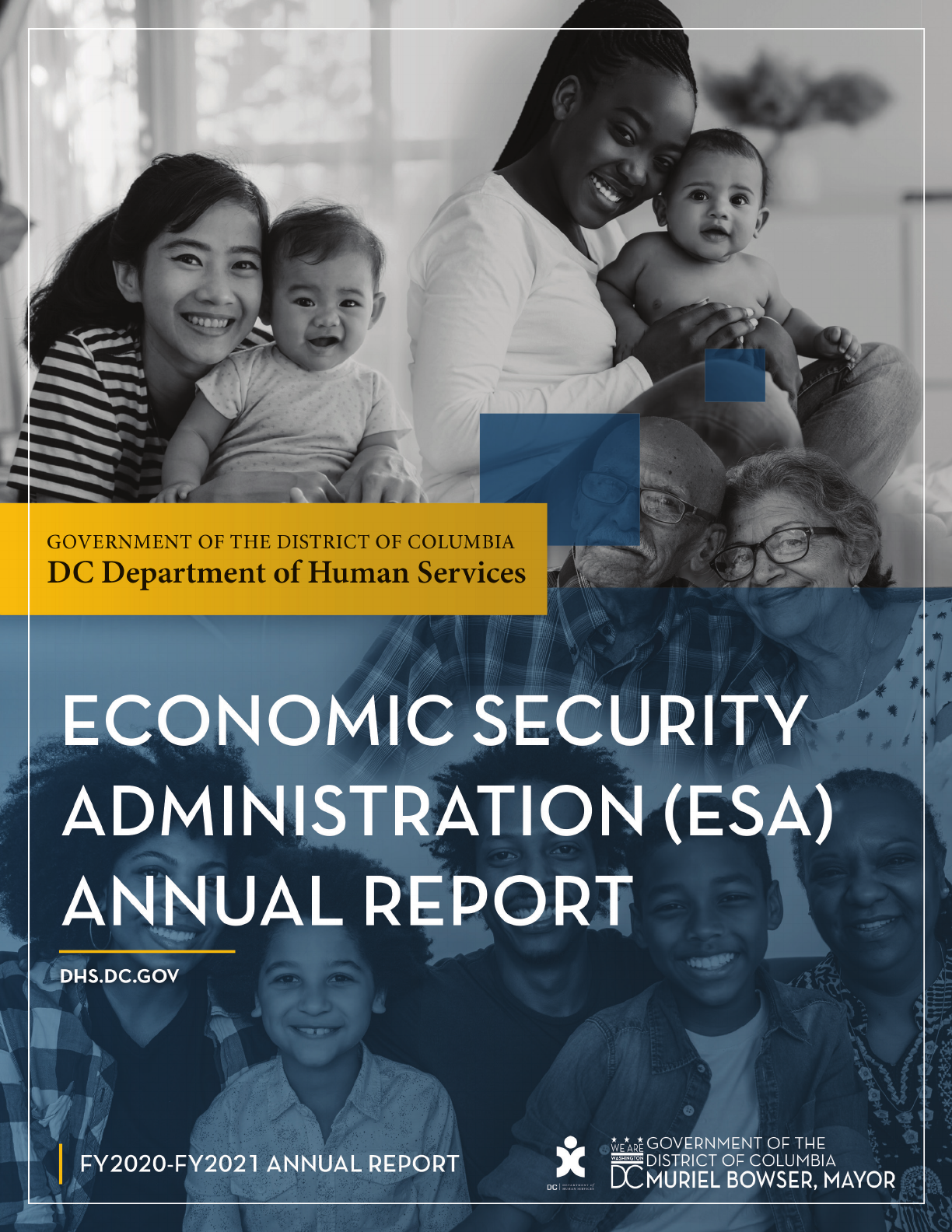
1
ESA FY2020-FY2021 ANNUAL REPORT
GOVERNMENT OF THE DISTRICT OF COLUMBIA
DC Department of Human Services
TANF 2-Gen
PROGRESS REPORT

2
ESA FY2020-FY2021 ANNUAL REPORT
WE AIM TO EMPOWER
EVERY DISTRICT RESIDENT TO REACH THEIR
FULL POTENTIAL
BY PROVIDING MEANINGFUL CONNECTIONS TO
WORK OPPORTUNITIES, ECONOMIC ASSISTANCE, & SUPPORT SERVICES
ESA
DISTRICT OF COLUMBIA
Department of Human Services

3
ESA FY2020-FY2021 ANNUAL REPORT
Contents
Administrator’s Letter
4
Cash Assistance
20
Economic Services
Division Programs
7
Employment and
Training Services
28
Food Assistance
9
DHS Overview
and Budget
35

4
ESA FY2020-FY2021 ANNUAL REPORT
Administrator’s Letter
ESA Administrator Anthea Seymour
The Economic Security Administration (ESA) within the Department
of Human Services (DHS) oversees the District of Columbia’s (District)
public benefit programs, including food and cash benefits as well as
the eligibility of medical assistance programs, childcare services, and
engaging in cutting-edge programming to serve residents. This annual
report reflects the District’s food and cash assistance programs,
including Supplemental Nutrition Assistance Program (SNAP) and
Temporary Assistance for Needy Families (TANF). Data shared within
this report covers the District’s fiscal years 2020 and 2021, between
October 2019 and September 2021, highlighting the impact of the
COVID-19 Pandemic on the District’s residents.
During the COVID-19 Pandemic, or the public health emergency (PHE),
the DHS expanded access to public benefits by creating new tools, such
as a web portal and a mobile app allowing online submission of an
application. In addition, DHS actively utilized various communication
tools, including notices, robocalls, the DHS website, and social media, to
reach out to existing and potential DHS customers. The DHS received
an unprecedented volume of incoming calls and new applications,
particularly at the beginning of the PHE. In response to the changing
circumstance and need, DHS modified operations during the PHE –
adjusting services at three out of five Service Centers, expanding the
Call Center, and suspending or reducing the in-person services at the
Service Centers.

5
ESA FY2020-FY2021 ANNUAL REPORT
Administrator’s Letter (Cont’d)
ESA Administrator Anthea Seymour
In March 2020, at the start of the COVID-19 Pandemic, a total of 105,039 residents from 63,623
households and 32,858 residents from 13,020 households received SNAP and TANF benefits,
respectively. Immediately following the onset of the COVID-19 Pandemic, the number of
customers applying for food and cash assistance increased drastically while recertification
requirements for existing customers were waived. As a result, the number of people and
households receiving food and cash assistance increased consistently over a year, reaching its
peak in April 2021, when 143,260 residents from 88,531 households received SNAP benefits and
39,615 residents from 15,180 households with children received TANF benefits.
During the COVID-19 Pandemic, the District administered Emergency Allotment (EA), additional
food benefits to eligible households receiving SNAP benefits. Between March 2020 and September
2021, for 19 months, $173 million were disbursed to customers receiving SNAP as EA payments
in addition to $370 million as regular SNAP benefits. The DHS also opted to provide the Pan-
demic EBT (P-EBT) benefits to children enrolled in schools and childcare services who could not
receive their free or reduced meals due to the closure of the school buildings. The DHS issued
about $160 million in P-EBT benefits to 95,000 children for School Year SY19-20 and SY20-21.
The ESA budget for FY21 resulted in a total expenditure of $263.2 million, which includes $132.1
million in local funds, $128.2 million of federal funding, and $2.9 million of intra-District funds. The
approved budget for FY22 is expected to grow due to the the increased caseload and in-person
activities, which is reflected in the new budget ($287.3 million).
The demographic data sheds insight into the characteristics of customers that DHS serves
through ESA programs and services – a majority are Black/African American and live in Wards 7
and 8. Sixty-five percent (65%) of customers receiving SNAP benefits live in single households.
In FY21, the average SNAP monthly benefit was $259 per household. Females represent the head
of household for almost all families (95%) receiving TANF benefits. A third (33%) of residents
receiving TANF benefits live in a two-person household; another quarter (27%) live in a three-per-
son household. The average household size for customers receiving TANF was three, with an
average monthly TANF benefit amount of $578 per household.

6
ESA FY2020-FY2021 ANNUAL REPORT
Administrator’s Letter (Cont’d)
ESA Administrator Anthea Seymour
The District recently redesigned its TANF program by adopting a Two Generational (2Gen)
approach that values children’s enrichment, security, and well-being and the entire family’s
welfare. Effective April 2018, the District increased local TANF funds to cover cash benefits for
families who need assistance beyond the 60 months and would have otherwise lost their eligibility
due to the 60-month time limit of the federal TANF policy. The DHS also strengthened its TANF
Employment Program (TEP) and SNAP Employment and Training Program (SNAP E&T) through
the 2Gen lens. Under the coaching model guided by the 2Gen policy, coaches guide customers
towards education and employment goals and any other goals they have for their child(ren) and
families for success. In FY21, ESA managed the TEP performance-based contracts for job place-
ment and educational/occupational training services among a network of 16
providers. The District’s SNAP E&T Program is managed by the DHS SNAP E&T Office and 20
service provider organizations (grantees).
The primary source of data compiled herein is from DC Access System (DCAS), the public
benefits eligibility determination system for the Department of the Human Services (DHS),
Economic Security Administration (ESA) in the Government of the District of Columbia.
CATCH, the District’s TANF case management system, and the SNAP E&T database are
additional sources of data introduced in this report.
The ESA Division of Data, Analytics, Research & Evaluation (DARE) has made reasonable efforts
to ensure that the data presented in this report is as accurate as possible. Still, it disclaims any
responsibility for the accuracy, reliability, or completeness of raw data. In no event shall the ESA
become liable for any misinterpretation or misuse of the data. Use of any information produced
in this report must be fully acknowledged and cited. Inquiries on data presented herein can be
directed to Anthea Seymour, ESA Administrator at Anthea.Se[email protected]v.
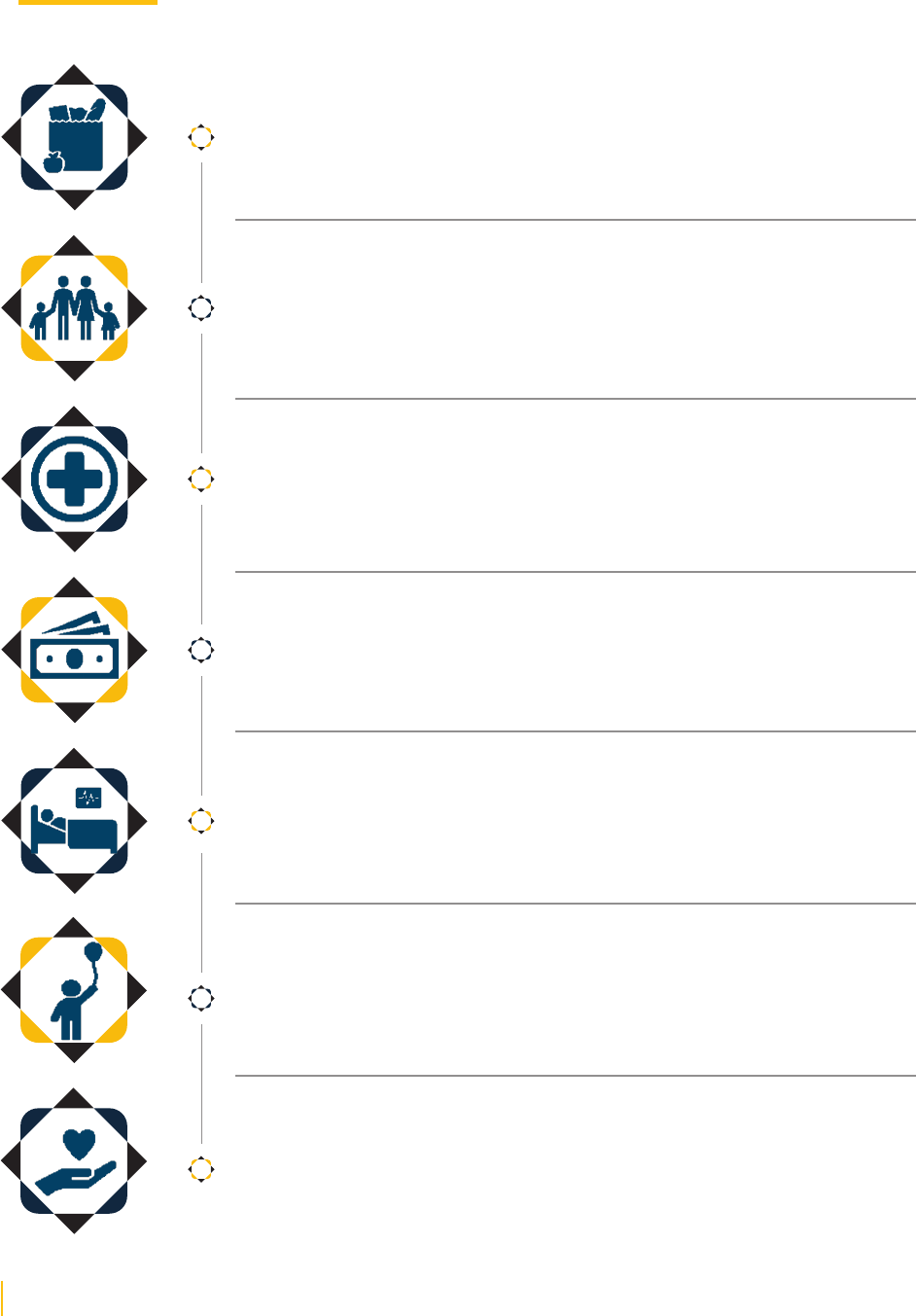
7
ESA FY2020-FY2021 ANNUAL REPORT
Economic Security Administration
(ESA) Program & Services
SUPPLEMENTAL NUTRITION ASSISTANCE PROGRAM (SNAP)
Federal benefit program that provides monthly food assistance to improve
access to food and nutrition.
TEMPORARY ASSISTANCE FOR NEEDY FAMILIES (TANF)
Blended local and federal program that provides monthly cash assistance for
families to meet their basic needs; employs a 2Generation approach and provides
supportive services to empower families.
MEDICAL ASSISTANCE
Local and federal benefit programs represented by Medicaid, Alliance and
Immigrant Children’s Program (ICP), providing health care coverage to
low-income residents. ESA is responsible for determining eligibility.
GENERAL CASH ASSISTANCE
Local benefit program that provides cash assistance to households caring
for unrelated children whose parents are absent.
INTERIM DISABILITY ASSISTANCE (IDA)
Local benefit program that provides cash assistance to residents who cannot work
due to a disability and have a pending Supplemental Security Income (SSI) application.
CHILDCARE
Blended local and federal programs that provide free or subsidized childcare
for residents participating in TANF or SNAP E&T programs.
BURIAL ASSISTANCE
Local program that subsidizes the cost of burial or cremation for residents
who lost a family member.

8
ESA FY2020-FY2021 ANNUAL REPORT
8
ESA FY2020-FY2021 ANNUAL REPORT
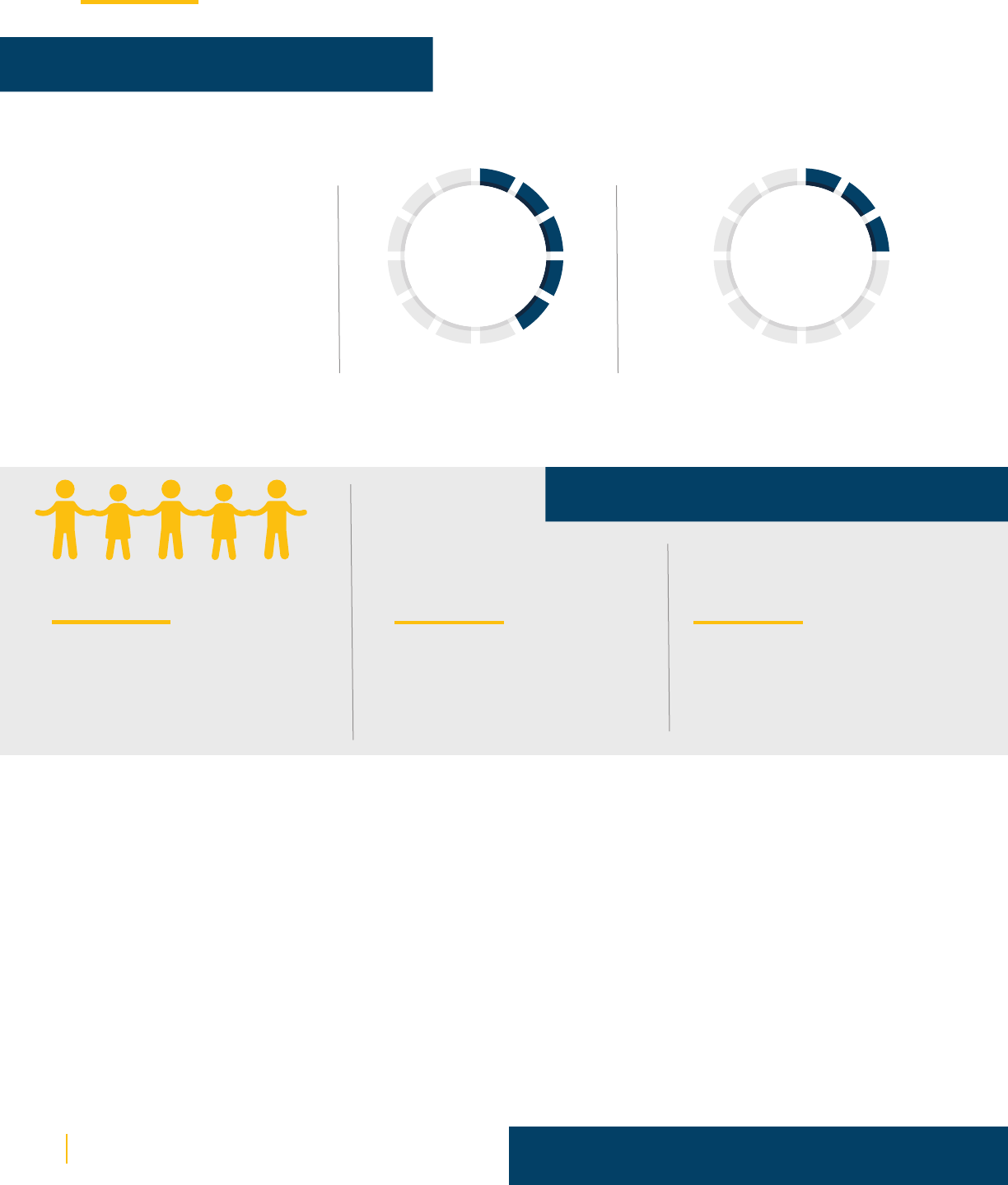
9
ESA FY2020-FY2021 ANNUAL REPORT
Calculation based on Census Bureau population estimate of 670,050 total District residents and 143,300
District residents who received SNAP benefits (April 2021). https://www.census.gov/quickfacts/DC
Median income is calculated using customers whose earned income is greater than $0.
Median income is measured two quarters after completing SNAP E&T program.
Data reported here is for FY21, unless otherwise noted
SNAP At a Glance
SNAP Program
District residents
received SNAP benefits
2
ONE IN
5
SNAP recipients
who are children
35%
District residents aged 60 years and
older who received SNAP benefits
3
17%
COVID-19 Measures
Emergency
allotments issued
$131 million
Pandemic EBT benefits
issued in school year
2020-2021
$102 million
School children received
P-EBT benefits in school
year 2020-2021
85,981

10
ESA FY2020-FY2021 ANNUAL REPORT
Supplemental Nutrition Assistance
Program (SNAP) Overview
SNAP helps low-income individuals and families by providing monthly benefits to purchase food. SNAP is one of
the most responsive benefit programs during economic downturns
4
, expanding to meet the need of the public and
then shrinking when the increased need recedes. During the COVID-19 Pandemic, the District exercised a number
of waivers, as permitted by the USDA, to provide flexibility and additional benefits to meet the nutritional needs of
residents in unprecedented circumstances.
Expedited SNAP (eSNAP), defined as ‘expedited service’ by FNS, is a way for residents to quickly receive access
to their SNAP benefits to cover their nutritional needs in the immediate future while DHS determines their overall
eligibility. Households with less than $150 in monthly gross income or gross income and liquid resources less than the
monthly rent will be eligible for this expedited service. The Local SNAP Supplement (LSS) is a locally funded program
that ensures customers receive a minimum monthly food benefit of $30 when the federal SNAP benefit is determined
below $30. Disaster SNAP (D-SNAP) benefits can be provided when a household experiences food loss due to a
natural disaster.
Transitional SNAP (T-SNAP) benefits are provided to households that stop receiving TANF benefits due to a change
in income for five months after the cash assistance ends. These programs are available to residents year-round.
Emergency Allotments (EA) were a response to the COVID-19 Pandemic that can be used to pay all customers the
monthly maximum SNAP benefit amount allowed for the respective household size, as discussed more in the SNAP
Benefit Issuance Section below.
4
Center on Budget and Policy Priorities, Factors Affecting SNAP Caseloads
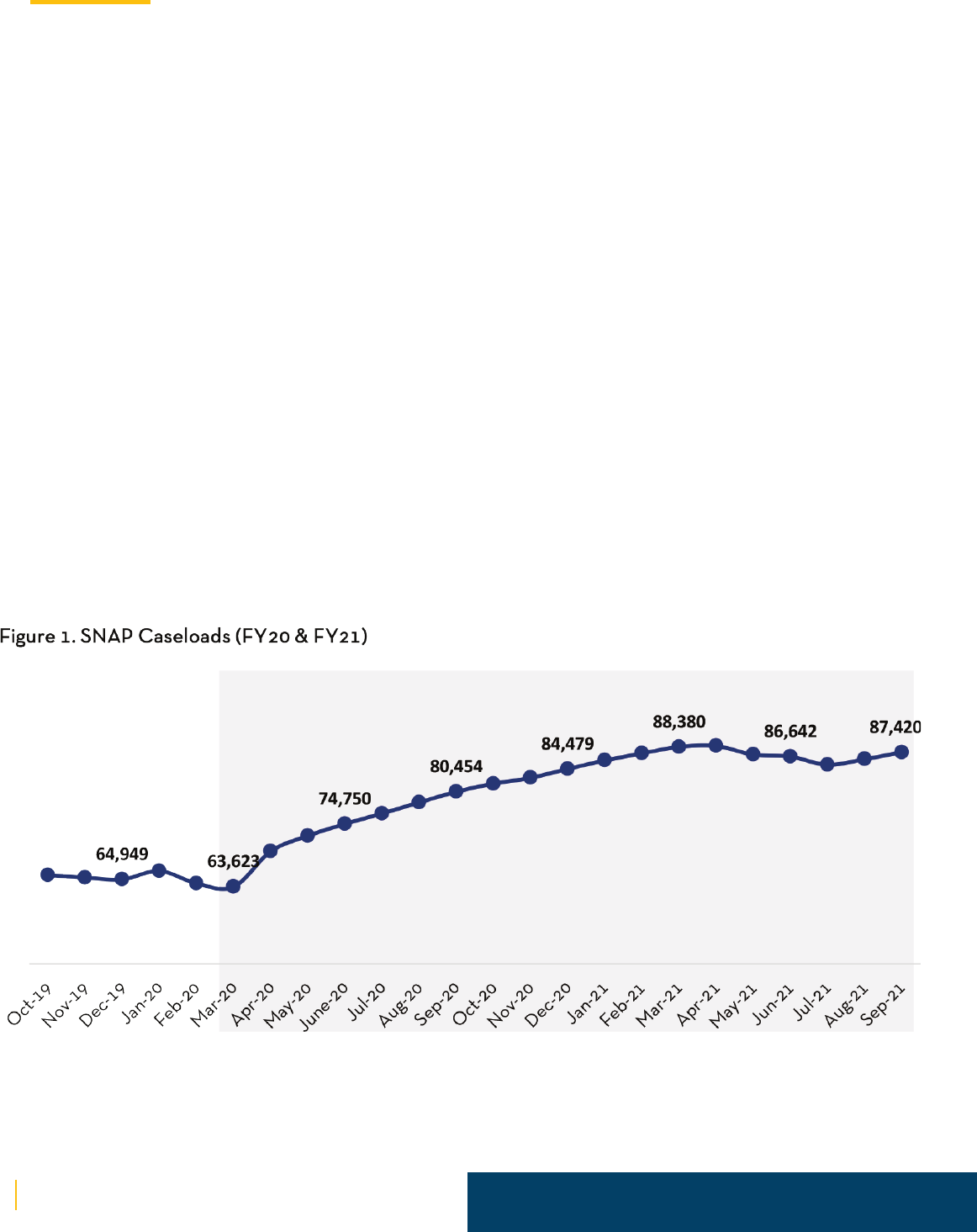
11
ESA FY2020-FY2021 ANNUAL REPORT
SNAP Caseload
At the start of FY20, before the COVID-19 Pandemic start-
ed, the SNAP caseload was consistently decreasing from
approximately 65,700 households (111,000 individuals) in
Oct 2019 to approximately 63,600 households (108,500
individuals) in March 2020. However, immediately following
the onset of the COVID-19 Pandemic, the number of
customers applying for SNAP benefits increased drastically.
At the same time, the SNAP recertification requirements
were waived, and the eligibility of existing SNAP
customers was extended by six months.
These changes resulted in a rapid and significant increase
in the number of households receiving SNAP benefits: the
number of households and residents receiving SNAP benefits
grew to 80,454 and 131,844, respectively, by the end of
FY20. As the COVID-19 Pandemic continued, the number
of households receiving SNAP benefits reached its peak at
88,531 (143,260 individuals).
Note: FNS waived the recertification process for customers receiving SNAP which began in March 2020 and continued
through the end of FY21. The lightly shaded area denotes the months the recertification process was waived. Note: Data
labels are provided for Q1, Q2, Q3, and Q4 of the fiscal year.
This is nearly 40% higher than the number of residents
receiving SNAP benefits in March 2020 and represents
one in five District residents.
As of March 2021, the District resumed its recertification
process, and customers who failed to complete their
recertification requirements lost their eligibility.
Subsequently, the District’s SNAP caseload gradually
declined until July 2021, when the trend reversed as a
result of the retroactive application of recertification
waiver. The District received authority from FNS to
retroactively waive the recertification process, reinstating
the SNAP eligibility of households who initially lost the
eligibility due to failure of recertifications between July
and September 2021, as the nation was battling through
another COVID-19 setback. As of September 2021, a
total of 87,420 households (140,314 individuals)
received SNAP benefits.
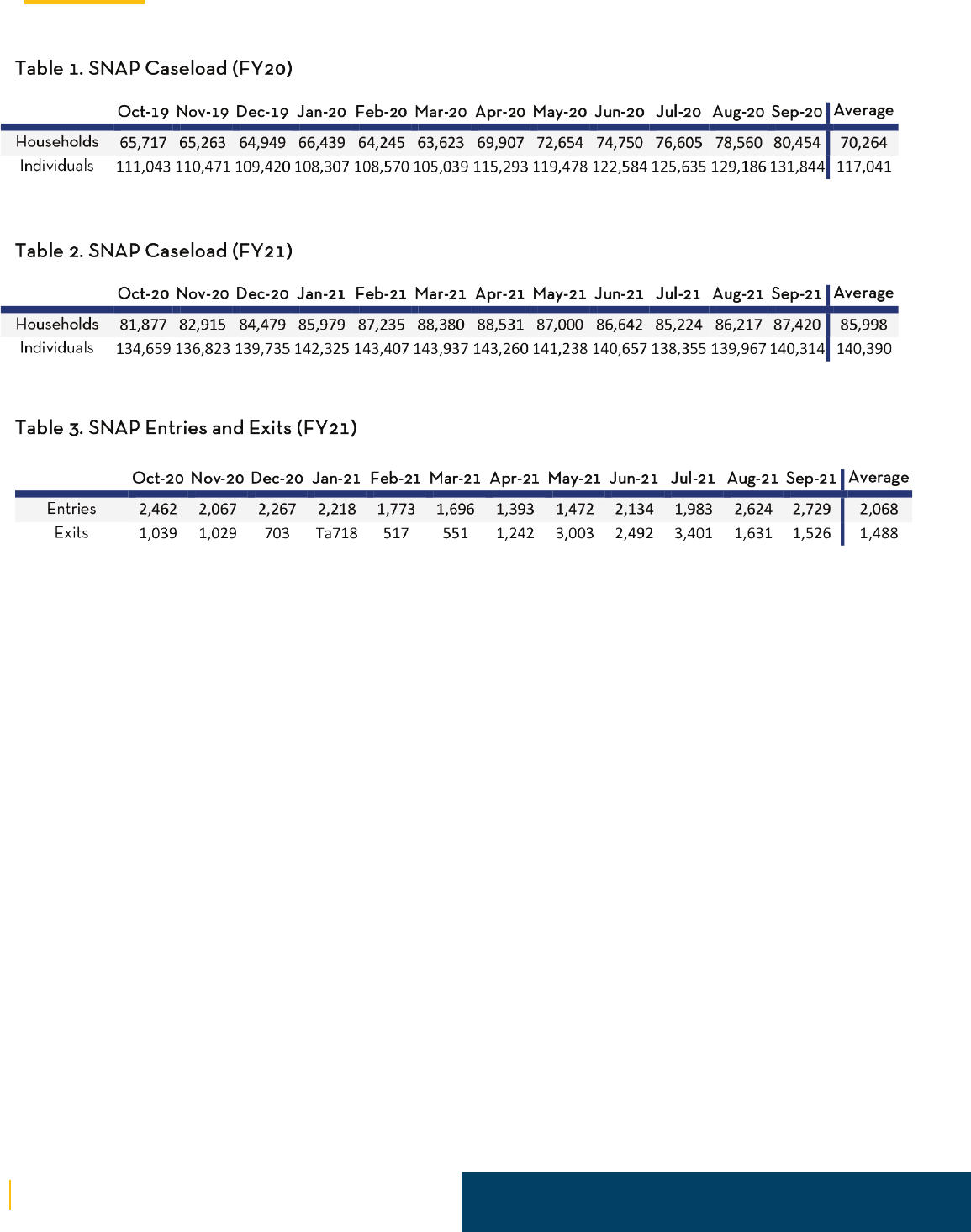
12
ESA FY2020-FY2021 ANNUAL REPORT
SNAP Caseload
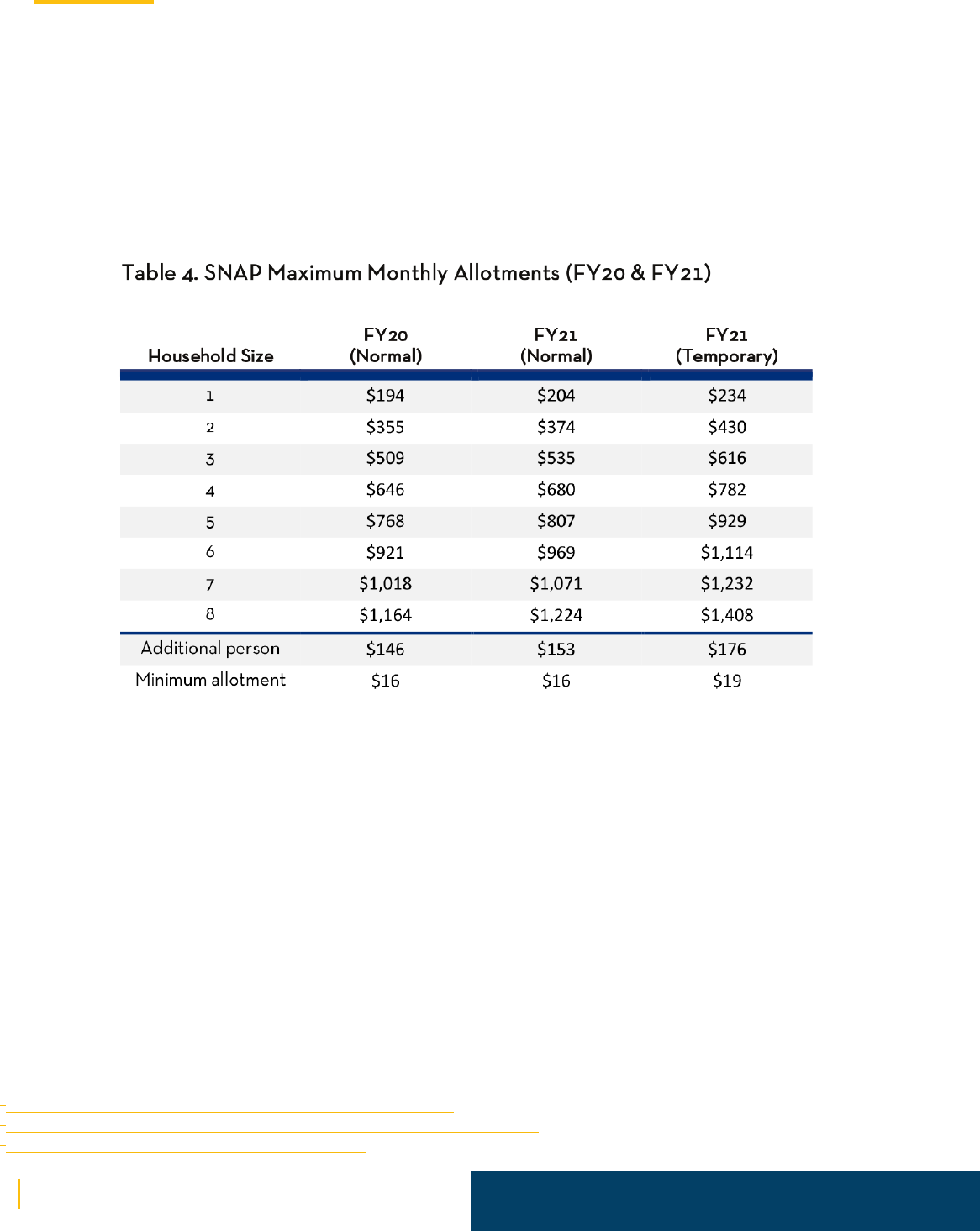
13
ESA FY2020-FY2021 ANNUAL REPORT
SNAP Benefit Issuance
SNAP benefits are calculated based on the cost of the Thrifty Food Plan (TFP), which is the lowest cost option of four food
plans the federal government develops to estimate the cost of a healthy diet across various price points.
5
SNAP maximum
allotments (benefit amounts) are updated each year and take effect on October
1.6
At the start of the COVID-19 Pandemic in March 2020, the maximum monthly allotment for a family of four was $646. However,
not all households receive the maximum amount, as the benefit can be reduced based on household income. The Families First
Coronavirus Response Act of 2020 allowed states to provide an Emergency Allotment (EA) to bring all households up to the
maximum benefit amount each month to help address food insecurity during the COVID-19 Pandemic, effective March 2020.
For example, a household of four receiving $500 a month in SNAP benefits would then receive an EA supplemental
payment of $146 to provide them with the maximum monthly allotment of $646. By 2020, the maximum SNAP allotment
for a family of four increased to $680, and EA payments continued. However, the Consolidated Appropriations Act of
2021, signed into law on December 27, 2020, temporarily increased the SNAP maximum benefit allotment. The increase
meant that the maximum allotment for a household of four increased from $680 to $782 effective January 1, 2021.
Although the increased rate was initially set to expire on June 30, 2021, the American Rescue Plan Act of 2021 extended
the temporary rate through September 30, 2021. The increased maximum allotments continued to provide additional
food benefits for customers to protect against increased food insecurity due to the COVID-19 Pandemic.
In April 2021, pursuant to President Biden’s Executive Order on Economic Relief Related to the COVID-19 Pandemic,
FNS issued new guidance that provided an EA benefit of at least $95 per month.
7
Whereas previously, a household of
four that was already receiving the maximum allotment of $646 would not receive any EA supplement, that household
then began receiving an EA supplemental payment of $95 per month. The District will continue to issue EA payments as
long as approved by FNS.
5
SNAP and the Thrifty Food Plan: What is the Thrifty Food Plan?
6
SNAP and the Thrifty Food Plan: How and when will SNAP benefits change?
7
FNS Emergency Allotment Guidance, April 1, 2021

14
ESA FY2020-FY2021 ANNUAL REPORT
SNAP Benefit Issuance
Figure 2. SNAP Benefit Issuance (FY20-FY21)
Note: Specific amounts for regular benefit and emergency allotment payments, along with the total benefits paid, can be
found in the accompanying tables below.
President Biden’s Executive Order also encouraged
FNS to reevaluate the Thrifty Food Plan. In August of
2021, FNS announced an increase in benefits effective
October 1, 2021, which represents the first time the
purchasing power of the plan was changed since it was
first introduced in 1975.
8
Maximum benefits for a family
of four rose to $835, an increase of $53 from
the previous year, giving District residents greater
assistance to meet their nutritional needs.
The impact of the changes in caseload described in
Section III. 1 and increases in benefits described above
led to a significant expansion in SNAP benefits going
to District residents each month. In March 2020, the
first month of the COVID-19 Pandemic, the number of
households and the total regular benefits stayed about
the same as the previous month. However, total benefit
issuance increased as households that were not eligible
for the maximum allotment began to receive additional
EA supplemental payments starting March 2020. Total
food benefits paid to District residents continued to
grow to a peak of $36.1 million in April 2021 due to a
combination of waived certification activities, increased
applications during the public health emergency, and
more financial assistance going to households through
EA and higher monthly allotments.
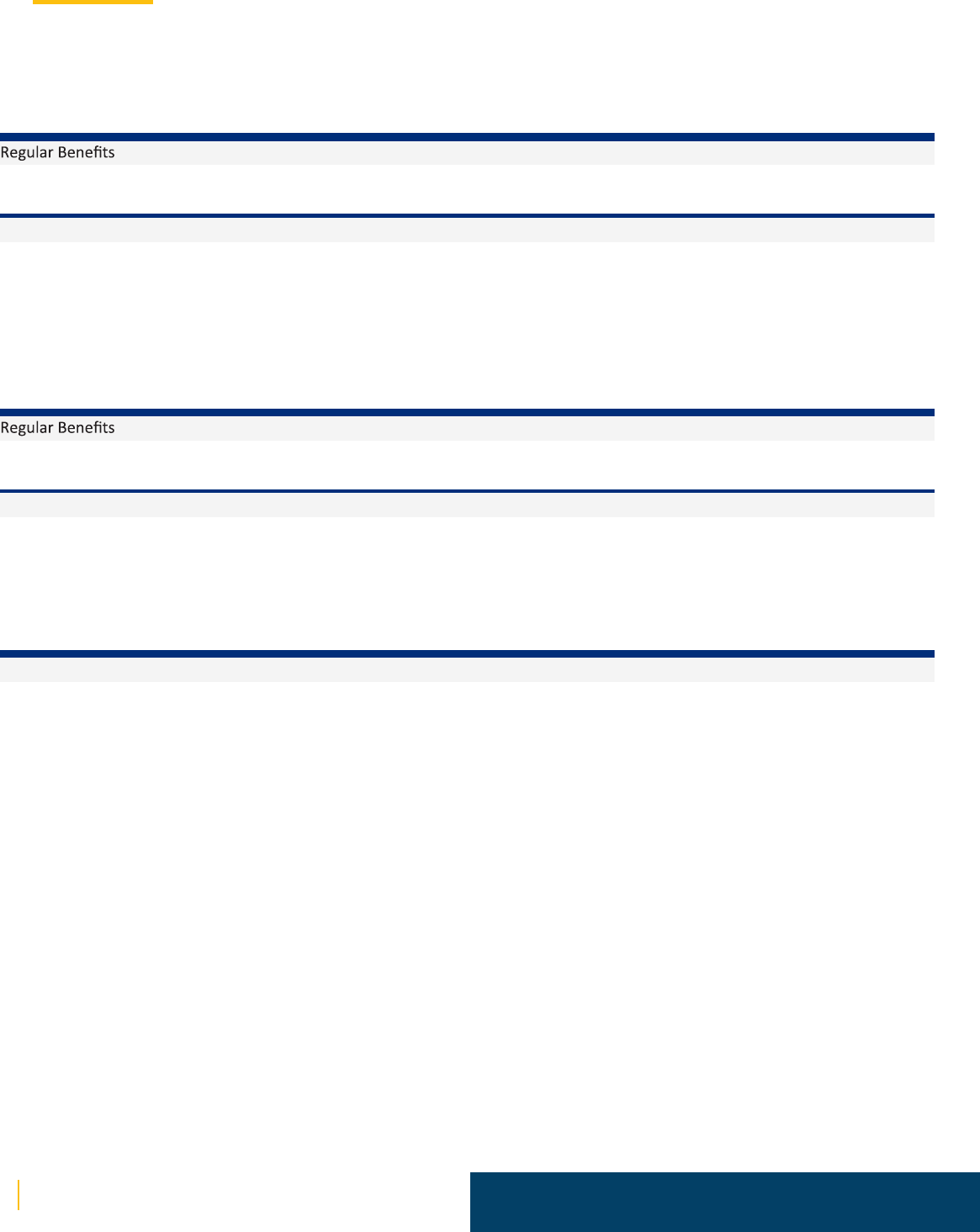
15
ESA FY2020-FY2021 ANNUAL REPORT
SNAP Benefit Issuance
Oct-19 Nov-19 Dec-19 Jan-20 Feb-20 Mar-20 Apr-20 May-20 Jun-20 Jul-20 Aug-20 Sep-20
$14.3 $14.3 $14.2 $14.3 $14.3 $14.3 $15.3 $16.2 $16.6 $17.0 $17.3 $17.5
Emergency
Allotments
$5.5 $6.2 $6.2 $6.2 $6.3 $6.2 $6.4
Total Payments $14.3 $14.3 $14.2 $14.3 $14.3 $19.8 $21.5 $22.4 $22.8 $23.3 $23.5 $23.9
Table 5. All SNAP Benefits Issuances (FY20)
Table 6. All SNAP Benefits Issuances (FY21)
Note: Emergency allotment payments began in March 2020. Benefit amounts are in millions.
Oct-20 Nov-20 Dec-20 Jan-21 Feb-21 Mar-21 Apr-21 May-21 Jun-21 Jul-21 Aug-21 Sep-21
$18.4 $18.6 $18.8 $22.2 $22.8 $23.3 $23.0 $22.3 $22.0 $21.4 $21.4 $21.5
Emergency
Allotments
$8.0 $7.3 $7.6 $9.2 $9.0 $8.4 $13.1 $13.0 $13.4 $13.9 $13.8 $13.7
Total Payments $26.4 $25.9 $26.4 $31.4 $31.8 $31.7 $36.1 $35.3 $35.4 $35.3 $35.2 $35.2
Table 7. Emergency Allotment Issuance by Month (FY21)
Oct-20 Nov-20 Dec-20 J an-21 Feb-21 Mar-21 Apr-21 May-21 Jun-21 Jul-21 Aug-21 Sep-21
Households 47,433 42,922 45,023 50,668 49,785 46,899 88,246 86,370 86,625 85,224 86,083 87,161
Individuals 91,178 8 5,114 89,804 9 8,644 96,922 8 9,905 143,719 142,020 140,629 138,355 139,749 139,772
Note: Benefit amounts are in millions.
M
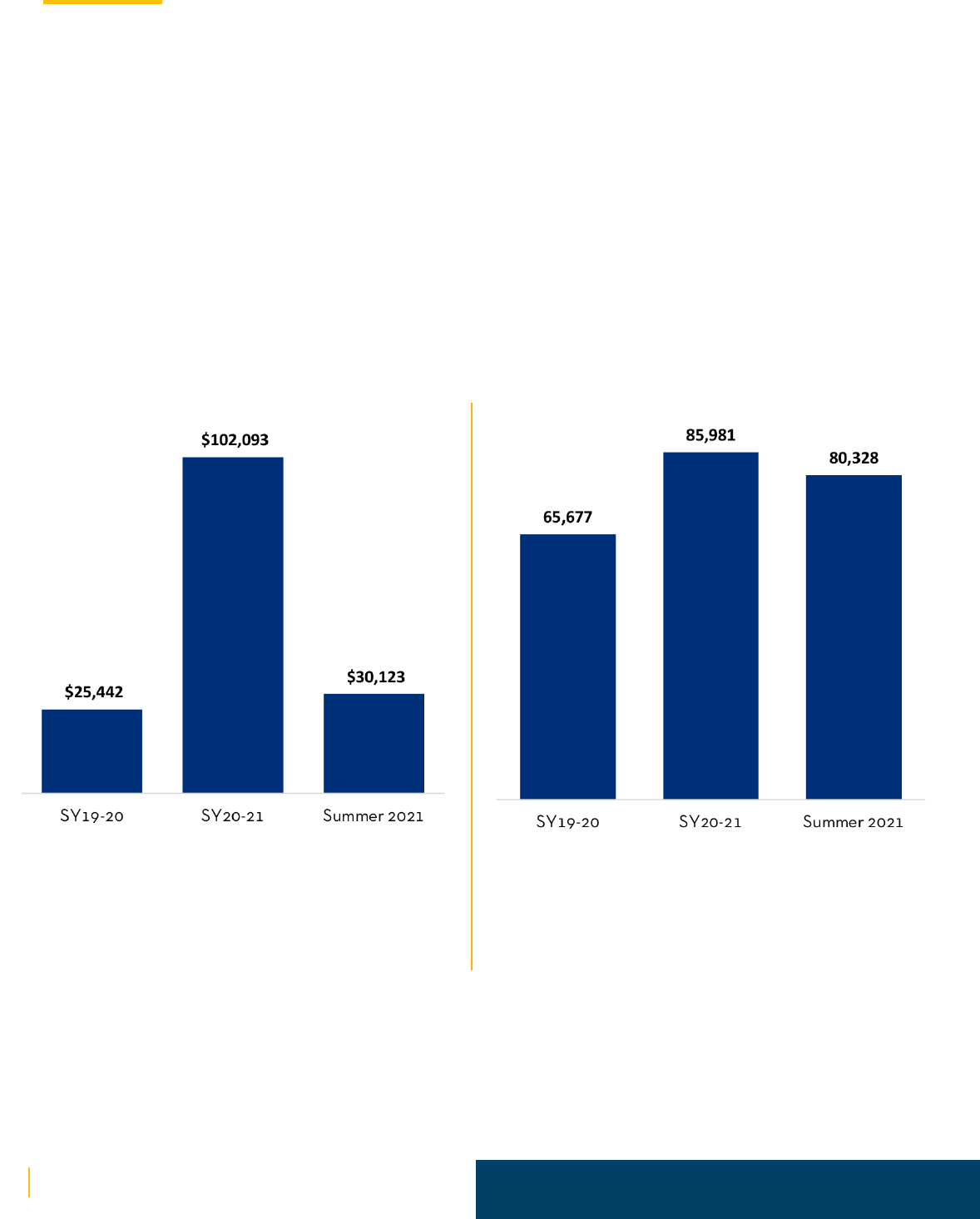
16
ESA FY2020-FY2021 ANNUAL REPORT
Pandemic EBT (P-EBT)
Pandemic EBT (P-EBT) was a new program designed to provide monthly food benefits to students who lost access to
their free or reduced-price meals due to school closures and virtual learning during the COVID-19 Pandemic. The District
received approval from FNS to provide P-EBT benefits during School Years (SY)19-20, SY20-21, and summer 2021. Eligibility
for P-EBT benefits was determined by DC’s Office of the State Superintendent of Education (OSSE) – students had to ei-
ther be attending a Community Eligible Provision (CEP) school or had to apply and be approved for the Richard B. Russell
National Free and Reduced-Price Meals (FARM) program while meeting stage five enrollment criteria each month. Bene-
fits for SY19-20 were issued for months March through June 2020. Benefits for SY20-21 were issued for months August 2020
through June 2021. Benefits for summer 2021 were issued for July and August. P-EBT benefits for SY20-21 and summer 2021
included both school-age children and children enrolled in daycare; P-EBT benefits for SY19-20 were not issued to children in
daycares.
Note: This Figure displays P-EBT benefits issued by school
year. Benefit amounts are measured in thousands. Benefits
for SY19-20 were issued for months March through June
2020. Benefits for SY20-21 were issued for August 2020
through June 2021. Benefits for summer 2021 were issued
for the months of July and August.
Note: P-EBT benefits for SY20-21 and summer 2021
included both school-age children and children enrolled
in daycare; P-EBT benefits for SY19-20 were not issued
to children in daycares.
P-EBT benefits were valued at $5.70 per child per school day for SY19-20 and $6.82 per school day for SY20-21. In addition,
students received a flat rate of $375 in P-EBT benefits for summer 2021. In total, between May 2020 and October 2021, ESA
administered 157.7 million in P-EBT benefits to around 95,000 unique students and children under age 6 in the District.
Figure 3. Total P-EBT Benefit Issuance
Figure 4. Children Receiving P-EBT Benefits
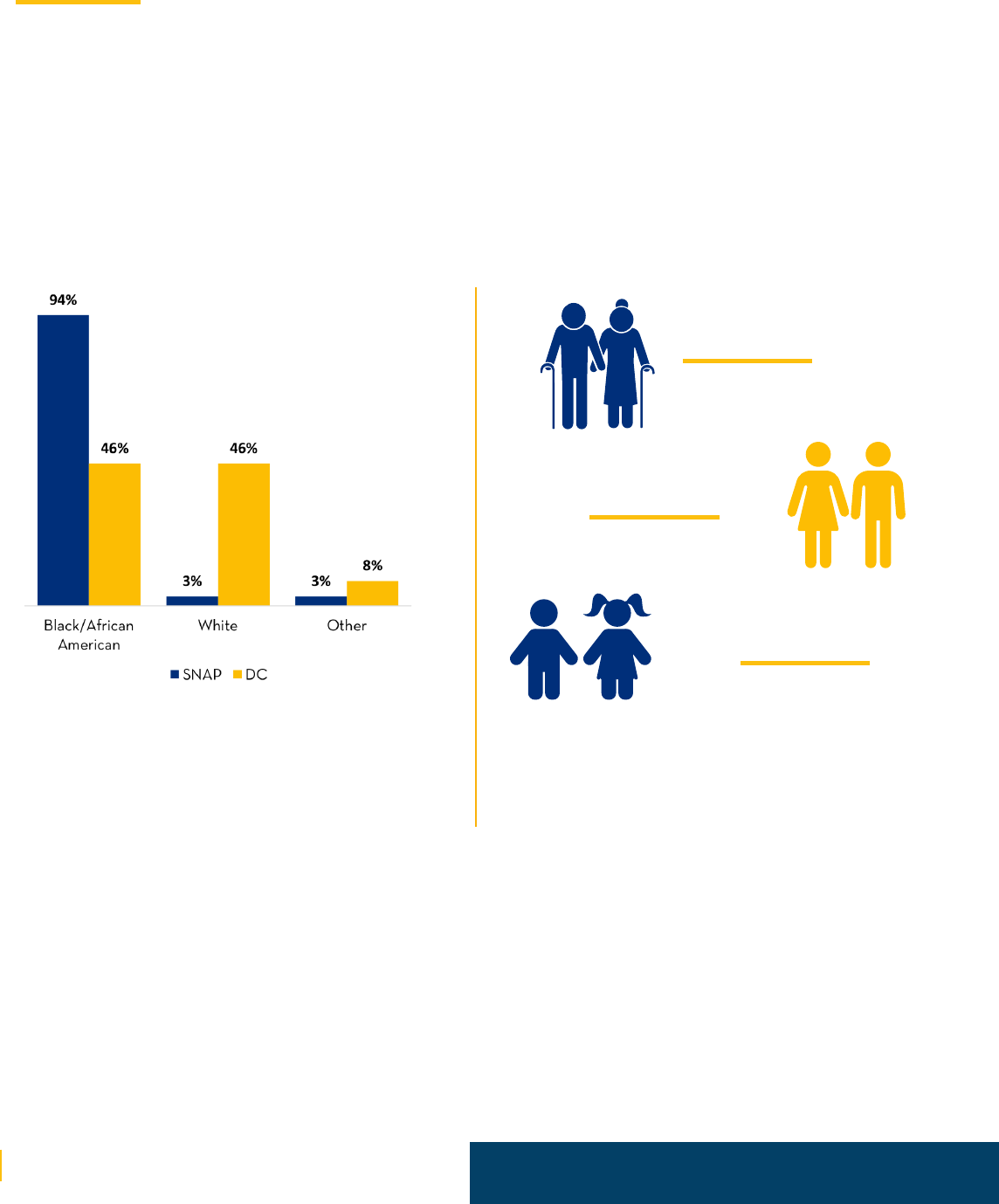
17
ESA FY2020-FY2021 ANNUAL REPORT
Demographics for Households
Receiving SNAP Benefits
According to the race data reported for the residents receiving SNAP benefits in April 2021, Black/African American
residents are disproportionately represented within the SNAP population. Black/African American residents make up
94% of customers receiving SNAP benefits (measured as heads of households), despite only making up 46% of the
population in the District (US Census, 2020).
Seniors (60+)
14%
Adults (18-59 years)
51%
Children (younger than 18)
35%
Figure 5. Racial Disparity of
Individuals Receiving SNAP
Figure 6. Age Breakdown of
Residents Receiving SNAP
Note: Data is for April 2021 and is based on cases where
heads of households’ race information was reported
(n=21,400). DC population data is according to US Census
Bureau (2020).
Note: Data is for April 2021 (n=143,719).
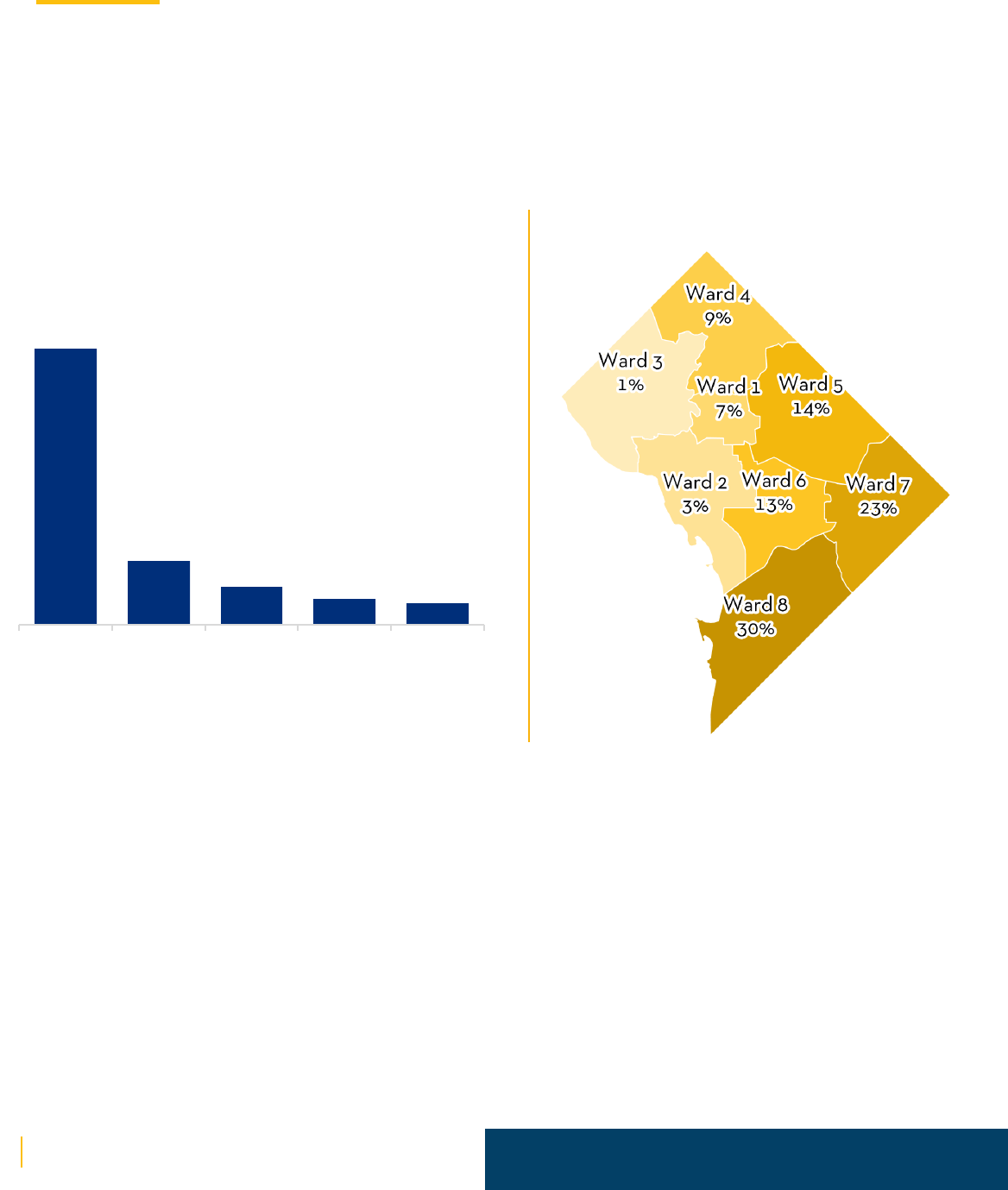
18
ESA FY2020-FY2021 ANNUAL REPORT
Households receiving SNAP benefits are concentrated in Wards 7 (23%) and 8 (30%). While Wards 7 and 8
constitute 24% of residents, they represent 53% of households receiving SNAP. This disparity indicates that pov-
erty in the District is concentrated in these two wards. Additionally, Wards 7 and 8 are primarily Black/
African American residents; 92% and 89%, respectively.
Demographics for Households
Receiving SNAP Benefits
65%
15%
9%
6%
5%
1 2 3 4 5+
Figure 7. Size of Households Receiving SNAP
Figure 8. Geographic Distribution of
Households Receiving SNAP

19
ESA FY2020-FY2021 ANNUAL REPORT
19
ESA FY2020-FY2021 ANNUAL REPORT
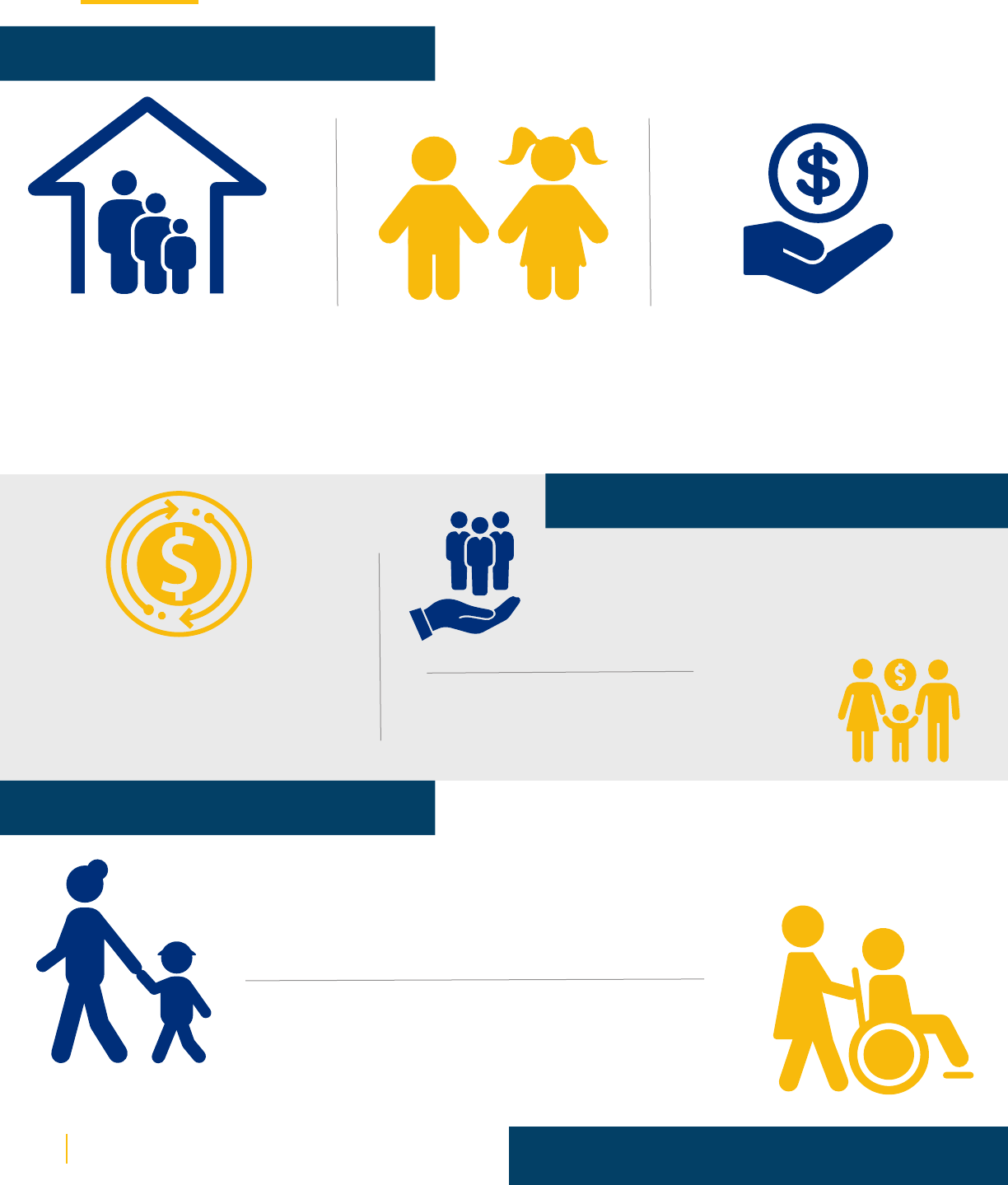
20
ESA FY2020-FY2021 ANNUAL REPORT
Cash Assistance At a Glance
TANF Program
$578
Average monthly TANF
benefit per household
Number of children who
received critical cash
assistance through TANF
26,300
Cash assistance provided to
District residents to purchase
everyday essentials like soap, toilet
paper, and diapers
$102 million
Amount spent on education, training,
and employment assistance for
customers receiving TANF
$24 million
Assessments completed to match customers with
resources and supportive services aimed at improving
the health and well-being of both parents and children
3,513
Children received a childcare subsidy to pay for high
quality childcare so parents could forge a path forward
through education, employment, and personal growth
3,693
Other Cash Assistance
Support & Assistance
Caregivers of unrelated children received general cash assistance to
help alleviate the financial burden associated with raising children
139
Individuals received Interim Disability Assistance (IDA) to help
meet their everyday needs and pay for medical expenses
373

21
ESA FY2020-FY2021 ANNUAL REPORT
Cash Assistance Overview
Unlike SNAP, the cash assistance programs allow the customers to use ‘cash’ benefits for a wide range of needs,
including non-food purchases and ATM withdrawals. The largest cash benefit program, TANF, is designed to
provide cash assistance and supportive services to families with children. Additionally, General Assistance for
Children (GAC) provides cash assistance to households caring for unrelated children whose parents and other
relatives are absent from the household and who do not, or cannot, provide financial support for the care of the
child. The District also provides Interim Disability Assistance (IDA), temporary financial assistance to those who
do not have dependents, are unable to work due to a disability, and have a high probability of receiving federal
Supplemental Security Income (SSI). Refugee Assistance (RA) is another form of temporary cash assistance
program for qualifying persons from foreign countries seeking a safe place of refuge.
The ESA offers additional benefits through subsidy programs. For example, families receiving TANF or SNAP
with childcare costs may be eligible to receive a Childcare Subsidy, which copays the childcare cost for eligible
families so caretakers are able to pursue education and employment. Tuition Assistance Program Initiative for
TANF (TAPIT) is another subsidy program that provides financial assistance to customers receiving TANF who
enroll in post-secondary educational programs or professional certificate and/or licensing programs. Finally, the
Burial Assistance Program subsidizes the cost of burial or cremation for residents who lost a loved one. Eligible
residents can receive a maximum of $1,000 towards the cost of a burial or $650 towards the cost of cremation
through the contracted funeral homes.

22
ESA FY2020-FY2021 ANNUAL REPORT
Temporary Assistance for Needy
Families (TANF) Overview
The federal TANF program, shaped by the Personal Responsibility and Work Opportunities Reconciliation Act
of 1996 (PRWORA), provides cash assistance to families with children in need, along with work requirements as
a condition to receive benefits. TANF provides each state a block grant and flexibility regarding how funds are
allocated, so long as they fulfill one of four broad categories:
1- Provide assistance to needy families so that children can be cared for in their own
homes or in the homes of relatives;
2- End the dependency of needy parents by promoting job preparation, work and marriage;
3- Prevent and reduce the incidence of out-of-wedlock pregnancies; or
4- Encourage the formation and maintenance of two-parent families.
The District recently redesigned its TANF program by adopting a Two Generational (2Gen) approach: the
Budget Support Act for FY 2018 allocated funding for the new 2Gen TANF policy, which centers on the
following program values:
• The enrichment, security and well-being of children is paramount and cash income to a
household is a protective factor for children; and
• Supporting parents to replace the income from TANF with income from work through
meaningful engagement in education and employment activities that increase their
economic security is a program requirement.
The PRWORA forbids the use of TANF funds to
provide cash assistance to a family for longer than 60
months (whether or not consecutive). Understanding
that cash in the home serves as a protective factor
for children, the District took great strides to work
within the flexibilities of the federal requirements.
Effective April 2018, per the Budget Support Act of
FY 2018, the District increased local TANF funds to
cover cash benefits for families who need assistance
beyond the 60 months and would have otherwise
lost their eligibility.
Additionally, the District allocated 80% of the TANF
grant as the Child Enrichment Grant to ensure
resources for children in the home even when the
caretaker fails to engage in work-related activities.
The remaining 20% is considered the Parent Grant.
The PRWORA requires states to apply a sanction policy
that eliminates the eligibility or reduces benefit amounts
for customers who do not participate in work-related
activities. Guided by the 2Gen policy, the District
lowered the sanction rate to 6% of the total TANF
benefits, which would equate to 30% of the Parent
Grant, for customers non-compliant with the work
requirements. The District’s TANF program also
provides a range of qualifying activities, allowing families
to address their personal needs and the needs of their
children, which often extend beyond employment.
This District’s TANF policy encourages parents to focus
on achieving their goals and their children’s goals
together and to ultimately gain self-sufficiency. It reflects
the District’s strong commitment to alleviating poverty
and helping families forge a self-directed path forward.
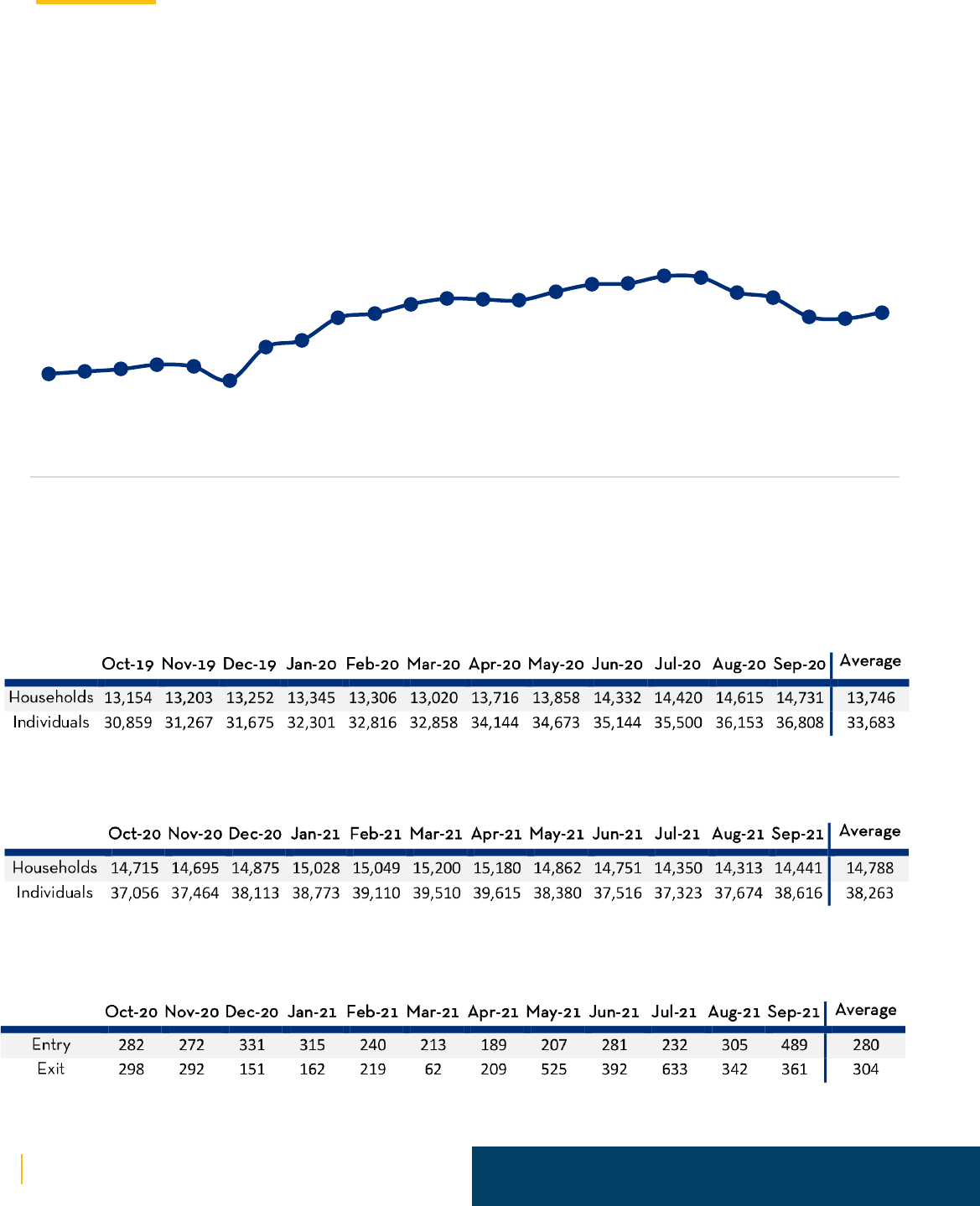
23
ESA FY2020-FY2021 ANNUAL REPORT
TANF Caseload
Consistent with the SNAP caseload trend, DHS has seen an upward trend in the TANF caseload and individuals
receiving benefits through FY20-21. Demand for TANF benefits reached its peak in March 2021, with DHS provid-
ing benefits to 15,200 households and 39,510 individuals. This represents a 14% increase in households and a 20%
increase in individuals receiving benefits compared to February 2020, pre-pandemic levels.
Figure 9. Households Receiving TANF Benefits (FY20-FY21)
13,252
13,020
14,332
14,731
14,875
15,200
14,751
14,441
Oct-19
Nov-19
Dec-19
Jan-20
Feb-20
Mar-20
Apr-20
May- 20
June-20
Jul- 20
Aug-20
Sep-20
Oct-20
Nov-20
Dec-20
Jan-21
Feb-21
Mar-21
Apr-21
May- 21
Jun-21
Jul- 21
Aug-21
Sep-21
Table 8. TANF Caseload (FY20)
Table 9. TANF Caseload (FY21)
Table 10. TANF Entries vs. Exits (FY21)
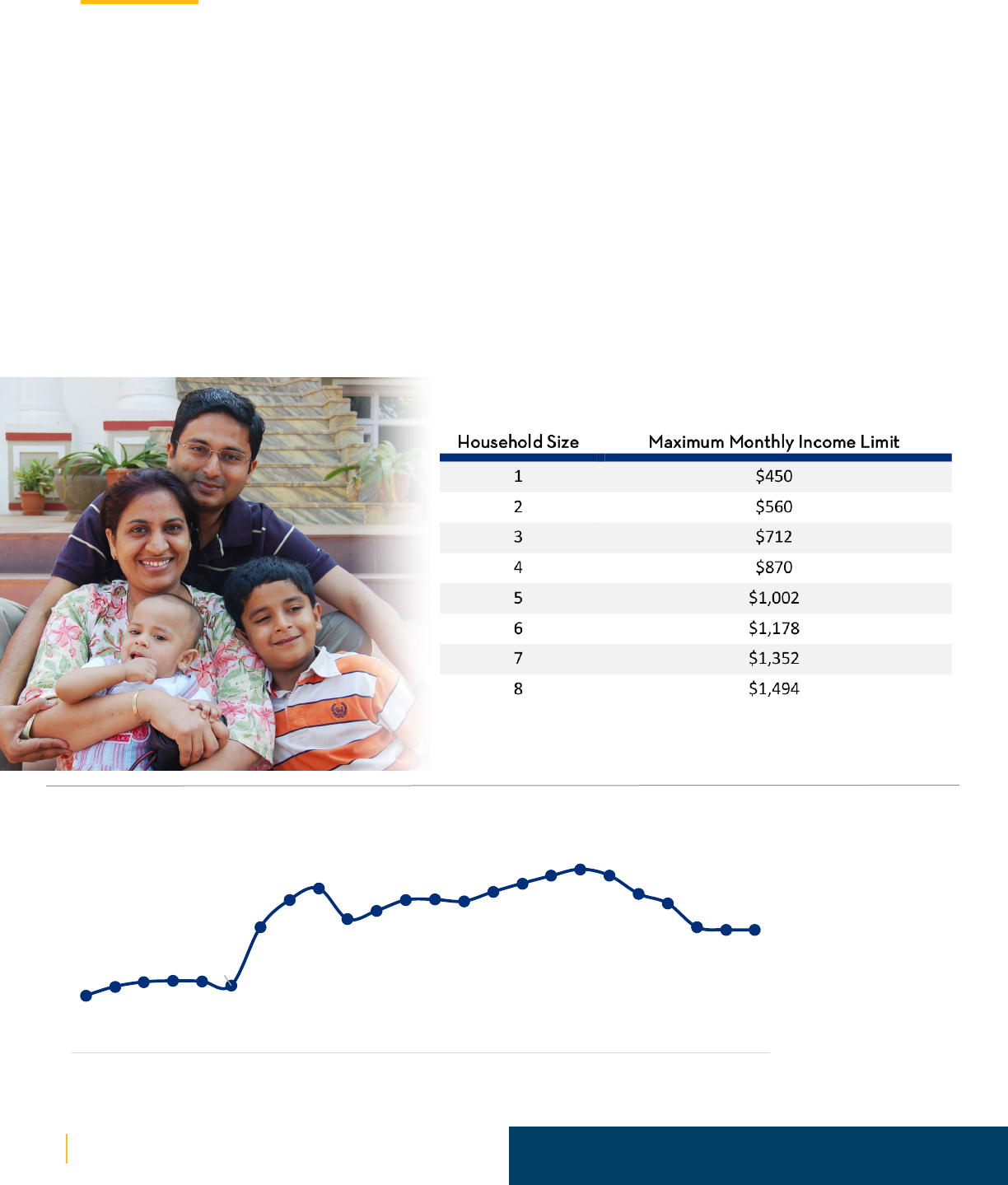
24
ESA FY2020-FY2021 ANNUAL REPORT
TANF Benefit Issuance
Families enrolled in the District’s TANF program may
receive benefits so long as they are income eligible
and have a child in the home. Like SNAP, the TANF
benefit amounts are determined based on household
size and income. Additionally, if a family has childcare
costs, the maximum monthly income limit increases
by $175 per child age two or over and $200 per child
under two.
Customers who choose not to participate in work-re-
lated activities or fail to report such activities per-
formed independently are sanctioned, and their
benefits are reduced by 6%. Customers who refuse
Table 11. Cash Assistance Maximum
Benefits FY20 and FY21
Figure 10. Total TANF Benefit Issuance (FY20-FY21)
Note: The maximum benefit rate above is applied to all cash
assistance programs, including TANF, IDA, GAC and RCA.
The rate did not change from FY20 to FY21.
$7.7 M
$7.7 M
$8.6 M
$8.5 M
$8.6 M
$8.8 M
$8.5 M
$8.2 M
Oct-19
N ov-19
Dec-19
Jan-20
Feb-20
Mar-20
Apr-20
May- 20
June-20
Jul- 20
Aug-20
Sep-20
Oct-20
N ov-20
Dec-20
Jan-21
Feb-21
Mar-21
Apr-21
May- 21
Jun-21
Jul- 21
Aug-21
Sep-21
Note: Data labels
are provided for Q1,
Q2, Q3, and Q4 of
the fiscal year.
or fail to report the absent parent’s information and
child support payment will also have their benefits
reduced by 25%.
During the first half of FY20, the total TANF benefits paid
out each month was about $7.7 million, approximately to
$566 per family. Since the start of the COVID-19 Pandemic,
DHS saw an immediate increase in the need for TANF, with
total benefit issuance rising to $8.5 million by the end of
FY20. As the number of families receiving TANF benefits
continued to increase in FY21, the total benefit issuance also
increased, reaching its peak at $8.8 million in March 2021.
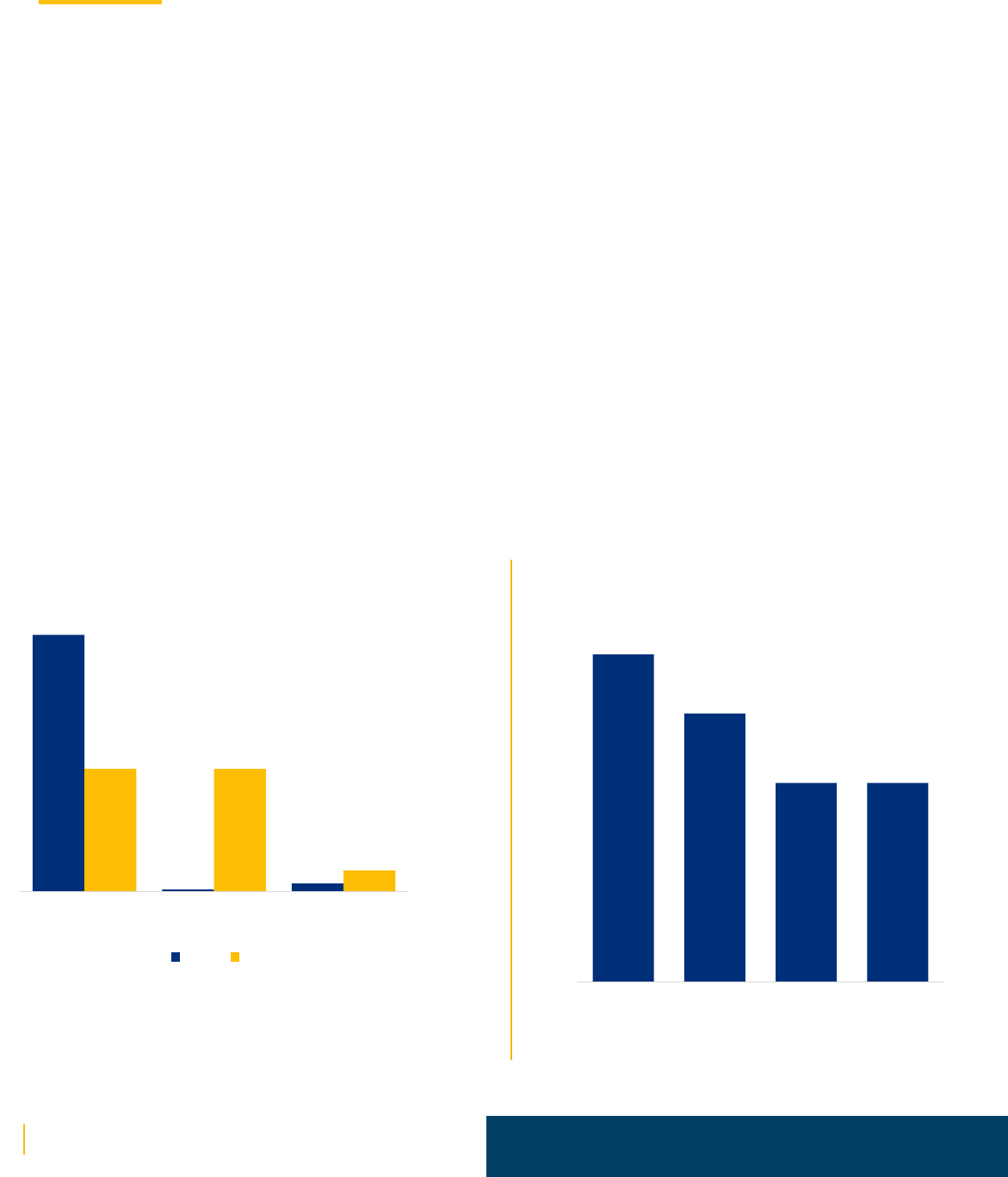
25
ESA FY2020-FY2021 ANNUAL REPORT
Demographics for Households
Receiving TANF Benefits
The TANF program only serves families. The only situation where an individual can receive TANF is if the
individual is an expectant mother. Therefore, it is not surprising that children are two-thirds (66%) of the
individuals receiving TANF. Most children who receive TANF benefits are young children -- 70% of children are
age ten years or younger (including elementary school, preschool, and under school age in Figure 15). Females
head almost all families (95%) receiving TANF benefits. Over half (60%) of residents receiving TANF benefits
live in a two- or three-person household. For FY21, the average household size was three, with an average
monthly benefit amount of $578.
Like residents receiving SNAP, a disproportionate number of Black/African American residents receive
TANF benefits. Of those who receive TANF benefits, 94% are Black/African American, compared to 46% of
DC residents who are Black/African American. And although 46% of DC residents are White, only 1% of
customers receiving TANF benefits are White.
There is also a significant geographic disparity in TANF benefit receipt, with a concentration of poverty in Wards
7 and 8. Two-thirds (67%) of households receiving TANF reside in Wards 7 and 8. Residents in Ward 7 make up
12% of the DC population, whereas 27% of households receiving TANF reside in Ward 7. The comparison is even
more drastic in Ward 8, where another 12% of residents live, but 40% of households receiving TANF.
Figure 11. Racial Disparity of
Individuals Receiving TANF
96%
1%
3%
46% 46%
8%
Black/African
Am eri can
White Other
TA NF DC
Note: Data is for April 2021 and represents only heads
of households receiving TANF. The race information was
available for 750 households receiving TANF. DC population
data according to US Census Bureau (2019, 2020).
Figure 12. Household Size of
Households Receiving TANF TANF
33%
27%
20% 20%
2 3 4 5+
Note: Data is for families receiving
TANF benefits as of April 2021.
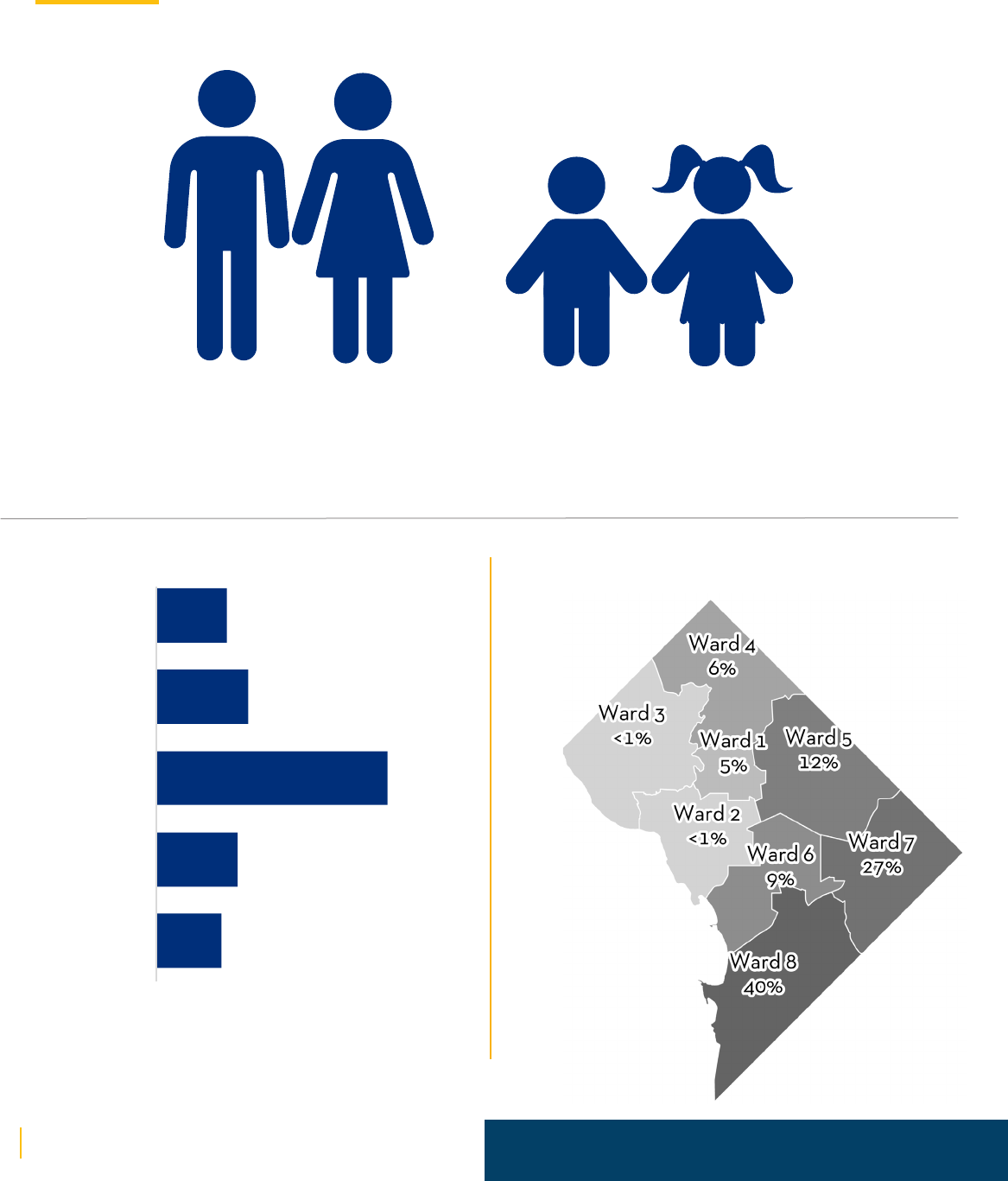
26
ESA FY2020-FY2021 ANNUAL REPORT
Demographics for Households
Receiving TANF Benefits
Figure 13. Size of Households Receiving TANF
34%
Note: Children have been defined below 18 years old as of April 30, 2021, while receiving TANF benefits as of April 2021. n = 39,600
66%
ADULTS CHILDREN
Figure 14. Children Receiving TANF by School Age
12%
15%
43%
17%
13%
Under School Age
PreK
Elementary School
Middle School
High School
Note: Data displayed is gathered from the approximately 26,300
children receiving TANF benefits in the District in April 2021.
Groupings: Under School Age (0-2 years), PreK (3-4 years),
Elementary School (5-10 years), Middle School (11-13 years),
High School (14-18 years). n = 26,300
Figure 15. Geographic Distribution of
Households Receiving TANF

27
ESA FY2020-FY2021 ANNUAL REPORT
27
ESA FY2020-FY2021 ANNUAL REPORT
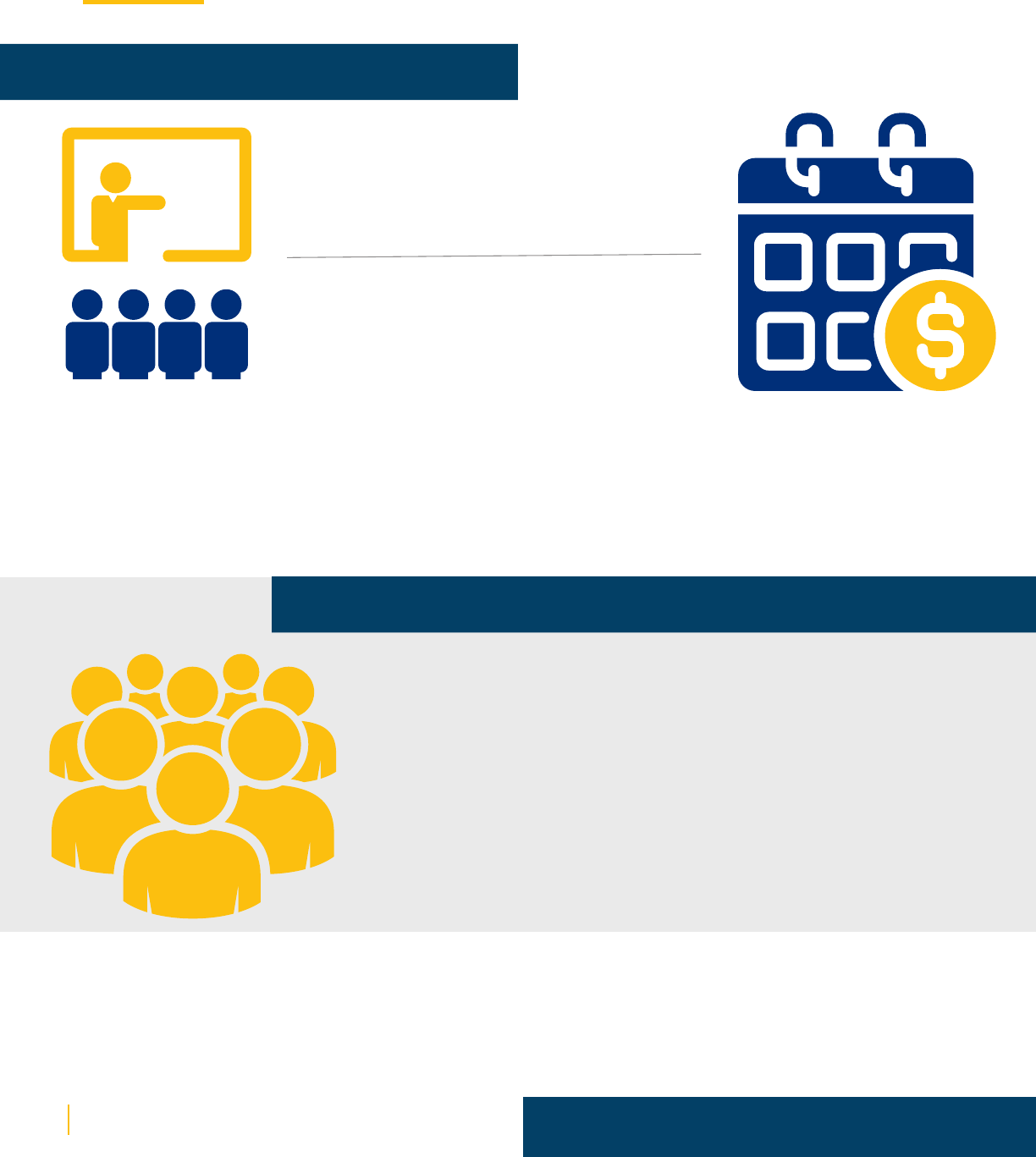
28
ESA FY2020-FY2021 ANNUAL REPORT
Employment and Training Services
At a Glance
SNAP Education & Training
Customers enrolled in education
and training through SNAP E&T.
1,289
The median monthly income for
employed SNAP E&T graduates
$4,067
Calculation based on Census Bureau population estimate of 670,050 total District residents (July 2021)
and 143,300 residents who received SNAP benefits (April 2021). https://www.census.gov/quickfacts/DC
Median income is calculated using customers whose earned income is greater than $0. Median income
is measured two quarters after completing SNAP E&T program.
TANF Employment and Education Program
of newly employed customers who were enrolled in
educational and occupational training through the
TEP earned a living wage.
92%
of customers who were enrolled in job
placement earned a living wage.
81%
customers received coaching to pursue
employment or education/training goals.
2,981

29
ESA FY2020-FY2021 ANNUAL REPORT
Employment and Training Services
The DHS provides residents receiving TANF and SNAP benefits with a suite of support services available to
eligible customers, including various referral services. Among those, these are the core services that are directly
managed by the DHS staff.
• TANF Comprehensive Assessment (TCA) is an eligibility requirement for customers receiving
TANF that should be conducted at the time of application or recertification. TCA creates an
opportunity to identify a customer’s priorities and engage in thoughtful planning about their
immediate goals. Following completion of a TCA and the planning process, a customer will be
paired with a coach who can help the customer obtain education or gainful employment as well
as other goals in their life or for their child(ren).
• TANF Education and Employment Program (TEP) is available to any customer receiving TANF
who want to receive coaching and various supports to accomplish their education and employment
goals and any other goals they have for their child(ren) and families for success. The TEP primarily
consists of job placement and educational/occupational training services. The ESA administers and
monitors their performance-based contracts with community-based providers. Customers who
successfully obtain and sustain employment can continue receiving additional support from their
TEP coach for one year after rolling off TANF benefits.
• SNAP Employment and Training Program (SNAP E&T) is a voluntary program that provides
coaching towards education and employment goals to SNAP customers who are not eligible
for TANF. The SNAP E&T employs a similar approach as guided by the 2Gen policy, working
with various service provider organizations across the District.
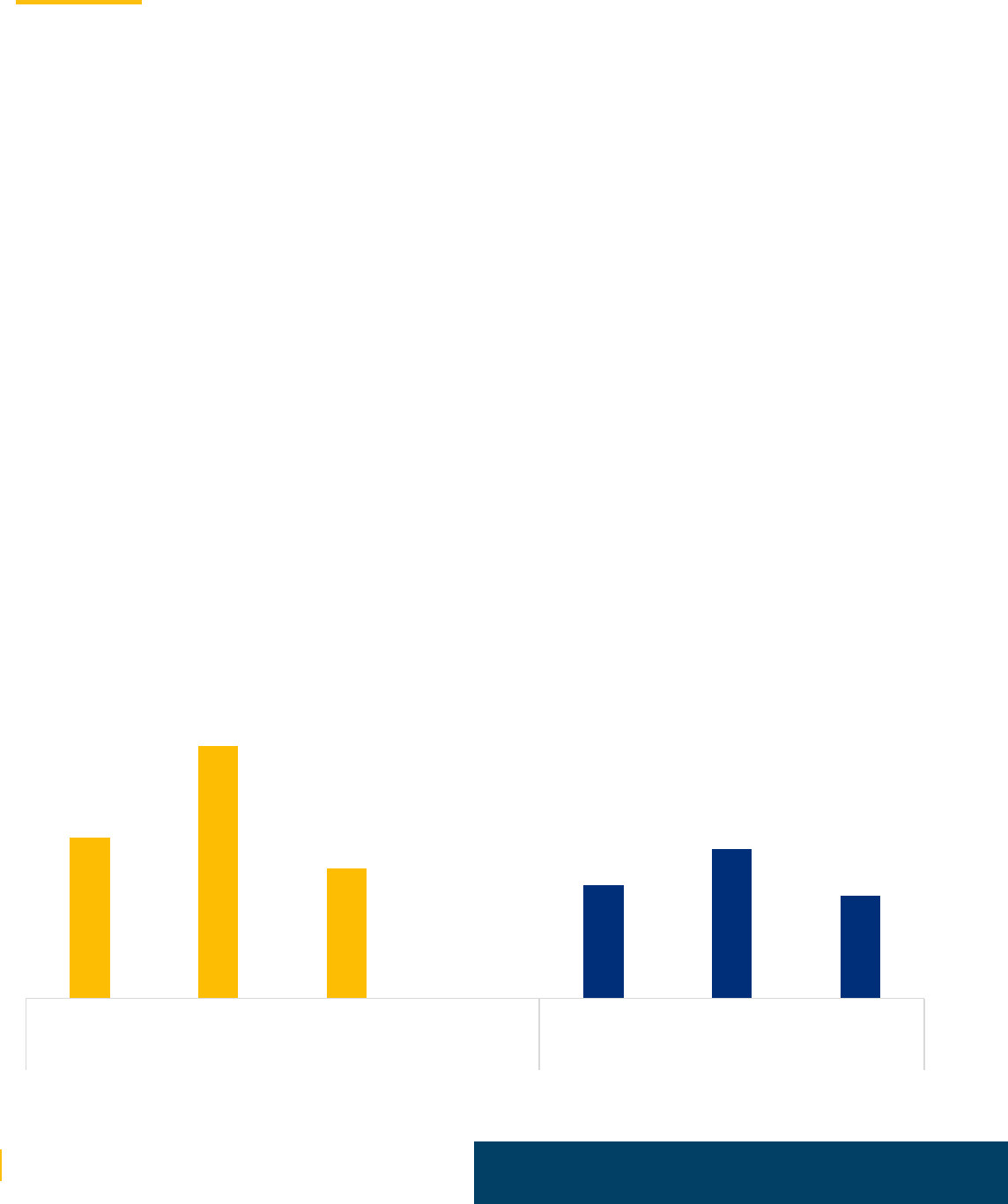
30
ESA FY2020-FY2021 ANNUAL REPORT
DHS’s 2Gen approach ensures that TEP coaches take a whole-family approach to planning and developing a
path forward that is inclusive of the entire family’s needs, which may include goals a customer has for their
child(ren). TEP coaches support customers, primarily focusing on helping a customer obtain education and or
gainful employment. The 2Gen approach allows TEP coaches to work with customers to identify the right mix
of qualifying activities to meet engagement requirements and include education or work-related activities
alongside activities related to their child(ren). Through the TEP, customers also gain access to a range of
support services and resources to facilitate their success – for example, childcare subsidies, tuition
reimbursement, travel stipends, referrals to various support services, such as housing and behavioral health.
The ESA manages the TEP employing performance-based contracts for job placement and educational/
occupational training services among a network of 14 providers. Customers who choose not to participate in
work or education-related activities may be referred to one of the TEP providers or the ESA’s Office of Work
Opportunity (OWO), whose coaching model provides more intensive support.
During FY21, on average, 1,659 customers were served by eight Job Placement Service Providers (JPSP)
each month. In comparison, 1,322 customers were served by six Education and Occupational Training Providers
(EOTP) in a given month. The number of customers served in FY21 decreased from FY20 due to the COVID-19
Pandemic. The lives of customers were disrupted, and it was difficult for TEP coaches to engage with custom-
ers without in-person interactions. Although TEP providers and OWO staff continued to support customers
through virtual tools, some qualifying activities were not available virtually.
TANF Employment and
Education Program (TEP)
Figure 16. Unique Customers Served by Job Placement Service Providers
and Education and Occupational Training Providers
2,053
3,214
1,659
1,453
1,898
1,322
FY19 FY20 FY21 FY19 FY20 FY21
JPSP EOT

31
ESA FY2020-FY2021 ANNUAL REPORT
Education, Employment & Wages
The new education/training enrollment rate increased to 73 (per 1,000 customers) in FY21 from 66 in FY20
among customers served by EOTPs. In contrast, the new employment rate (per 1,000 customers) declined to
22 in FY21 from 51 in FY20 among customers served by JPSPs, reflecting the impact of the COVID-19 Pandemic
on customers looking for work. Despite the significant drop in the new employment rate, the percentage of
customers earning a living wage
9
among those newly employed increased considerably. In FY21, 81% and 92%
of customers employed through JPSPs and EOTPs were earning at or above the District’s living wage.
38%
59%
81%
31%
57%
92%
FY19 FY20 FY21 FY19 FY20 FY21
JPSP EOTP
Figure 17. Percentage of Newly Employed Customers Earning Living Wage
9
The Living Wage Act of 2006, D.C. Official Code §§ 2-220.01 – 2-220.11, provides that District of Columbia
government contractors and recipients of government assistance (grants, loans, tax increment financing) in the
amount of $100,000 or more shall pay affiliated employee wages at no less than the current living wage rate.
As of Jun 30, 2021, the official living wage rate was $15 per hour, which was applied to calculate the above data.
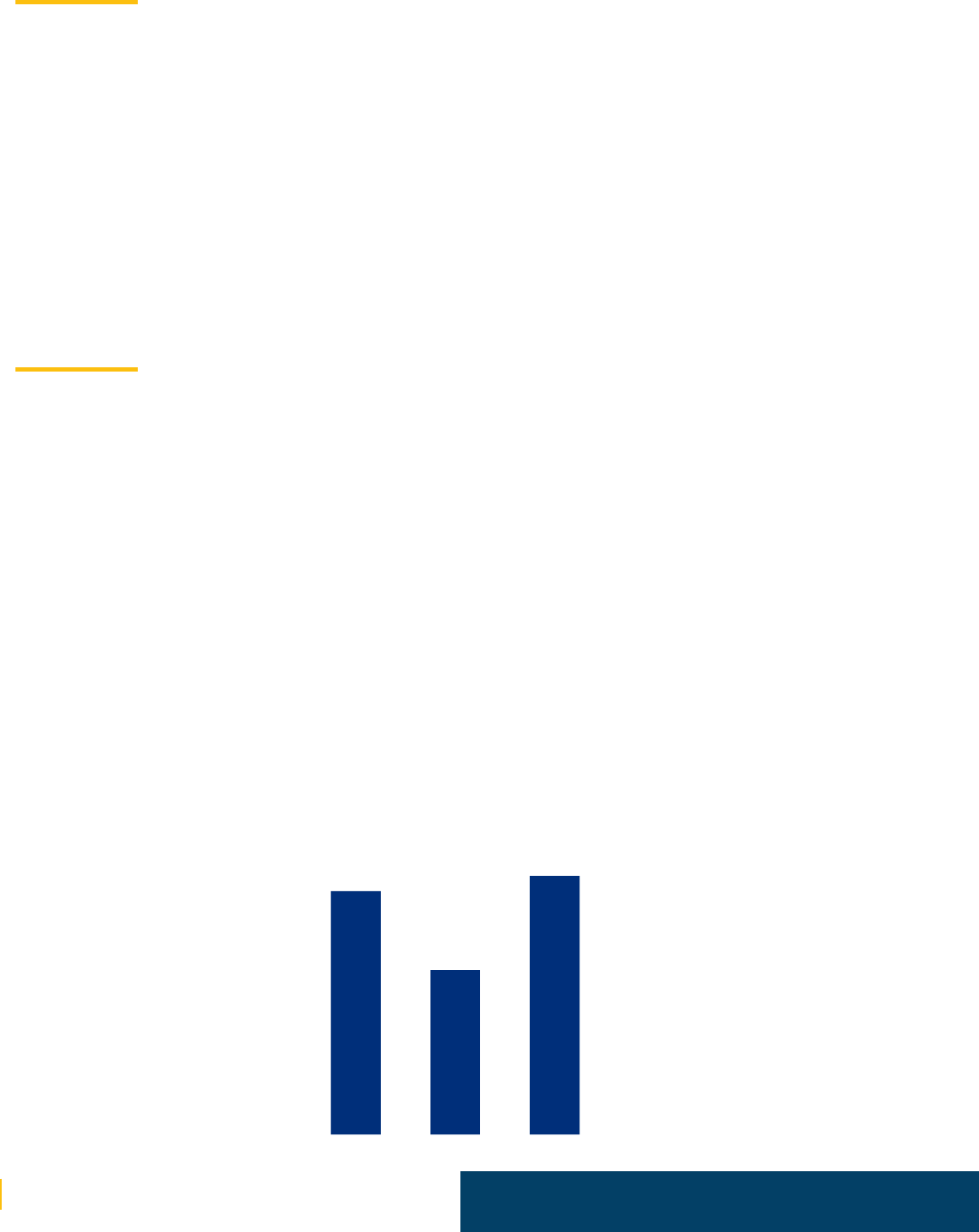
32
ESA FY2020-FY2021 ANNUAL REPORT
Work participation
Customers who actively participate in job placement and education or training-related activities receive various
supports for their efforts to reach their goals. Customers who continue to engage with the TEP coaches are likely
to achieve full participation, meeting their required activity hours as targeted in their Individual Responsibility
Plan (IRP). In FY21, among the customers served by JPSPs, 66% successfully met the goal of full participation,
while 53% of customers served by EOTPs did so. Activities the customers participated in include but are not
limited to job search, GED/SSED, vocational education, employment, and various 2Gen activities.
SNAP Employment and
Training (SNAP E&T) Program
The SNAP E&T Programassists customers receiving SNAP in achieving their career goals by providing a broad range
of services focused on their interests and needs. SNAP customers who do not receive TANF benefits can participate
in the SNAP E&T Program. The DC SNAP E&T program is entirely voluntary. Along with coaching support, partici-
pants can receive reimbursements for qualified transportation costs, childcare costs and other expenses related to
their participation.
The ESA SNAP E&T Division manages the District’s SNAP E&T Program, overseeing 20 training and employment
service provider organizations (Grantees). The SNAP E&T Office and Grantees guide the participants in obtaining the
education or training and job search skills necessary to become gainfully employed.
The number of customers participating in the SNAP E&T program decreased by 32%, from 1,212 in FY19 to 820 in FY20. In
large part, this was due to the effect of the COVID-19 Pandemic that made it difficult for potential customers to participate
in program activities effectively. However, the number of SNAP E&T participants rebounded noticeably in FY21, rising
to 1,289, a 57% increase from FY20, thanks to vigorous outreach efforts made by the SNAP E&T Office.
Figure 18. SNAP E&T Customers
1,212
820
1,289
FY19 FY20 FY21
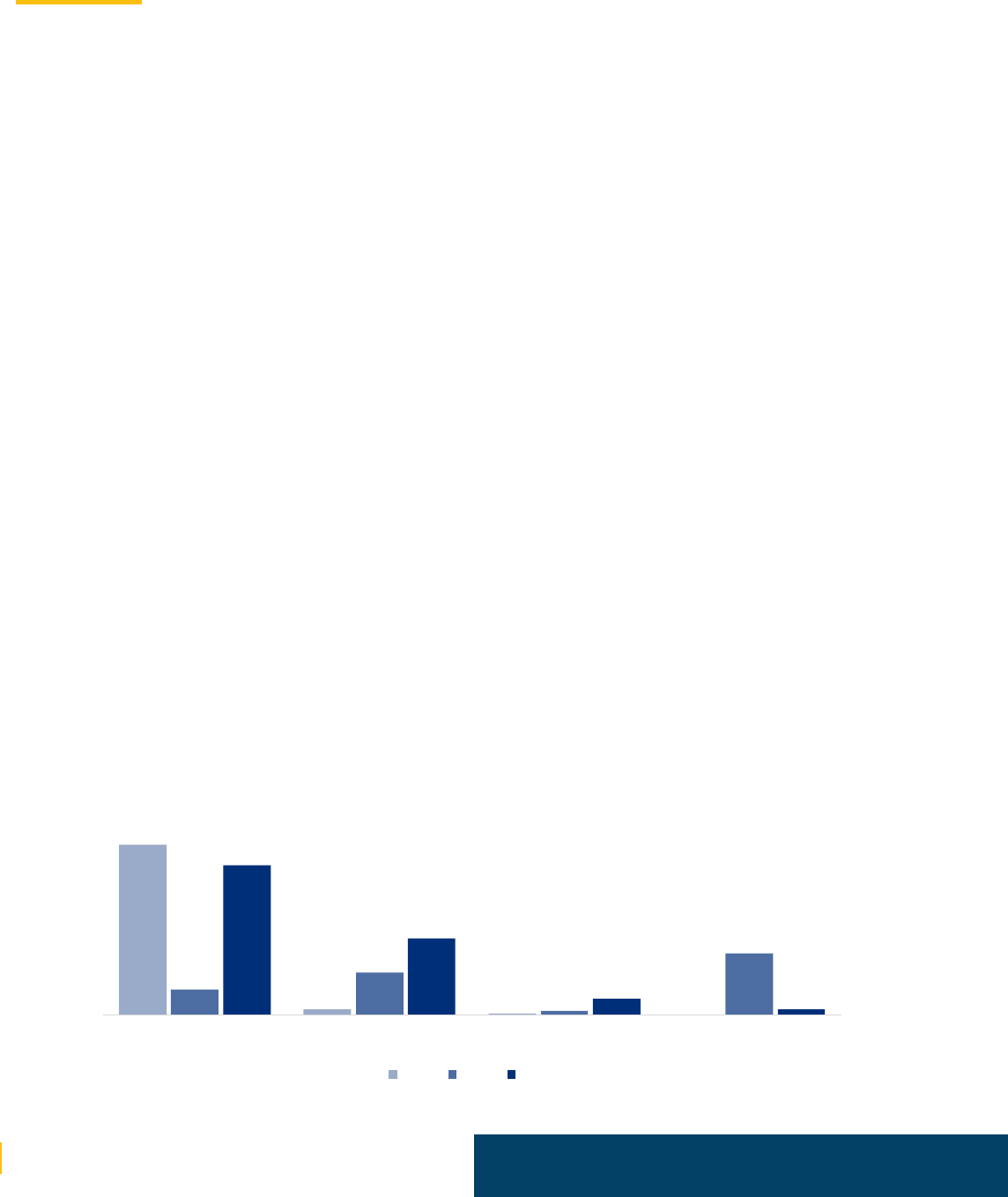
33
ESA FY2020-FY2021 ANNUAL REPORT
SNAP Employment and
Training (SNAP E&T) Program
The SNAP E&T Program activities are composed of the following four components:
Education Component: Activities include adult basic education; basic literacy; instruction leading to high school
equivalency (including GED or high school diploma); developmental or remedial education; career and technical
education programs or vocational training; and other educational disciplines.
Job Search Component: Activities consist of employability assessments; training in techniques to increase
employability such as interviewing, resume development, and job application techniques; job placement services; other
direct training or support activities, including educational programs, that can expand the job search abilities or employability
of customers. Customers in this Component must actively seek employment and receive sustained support from SNAP
E&T staff or a funded provider.
Job Retention Component: Activities consist of coaching, communication, training, or other services designed to en-
sure job retention after a customer has obtained employment, as well as assisting customers in obtaining eligible customer
supports that are likely to improve retention outcomes. Services must be provided for not less than 30 days but not more
than 90 days.
Improvability Component: Work activity (WA) and Work-Based Learning (WBL). WBL activities like internships,
apprenticeships, and on-the-job training may provide wages subsidized by the E&T program. Component activities can
also consist of active participation in a Registered Apprenticeship program authorized by the District, federal, or state
government in a pre-apprenticeship program designed to prepare individuals to enter and succeed in a Registered
Apprenticeship program.
Among those four components of the SNAP E&T program, the Education Component often appeals most to the E&T
customers: in FY19, 94% or 1,143 of all SNAP E&T customers completed at least one Education component. The rate
dropped considerably to 21% (173) during FY20 when the COVID-19 Pandemic started. However, the virtual programs
and activities were stabilized in FY21, increasing the interest and participation rate in the Education Component to
80%. The participation in both Job Search and Job Retention Components increased for the last two years despite the
challenges the customers and coaches faced during the COVID-19 Pandemic. It demonstrates the SNAP E&T Office and
grantees strong commitment to the continuous improvement of the program.
1,143
36
7
173
284
27
416
1,004
516
108
38
Educati on Job Search Job Retention Improvability
FY19 FY20 FY21
Note: Some customers participate in multiple components.
Figure 19. SNAP E&T Participation by Program Component

34
ESA FY2020-FY2021 ANNUAL REPORT
34
ESA FY2020-FY2021 ANNUAL REPORT
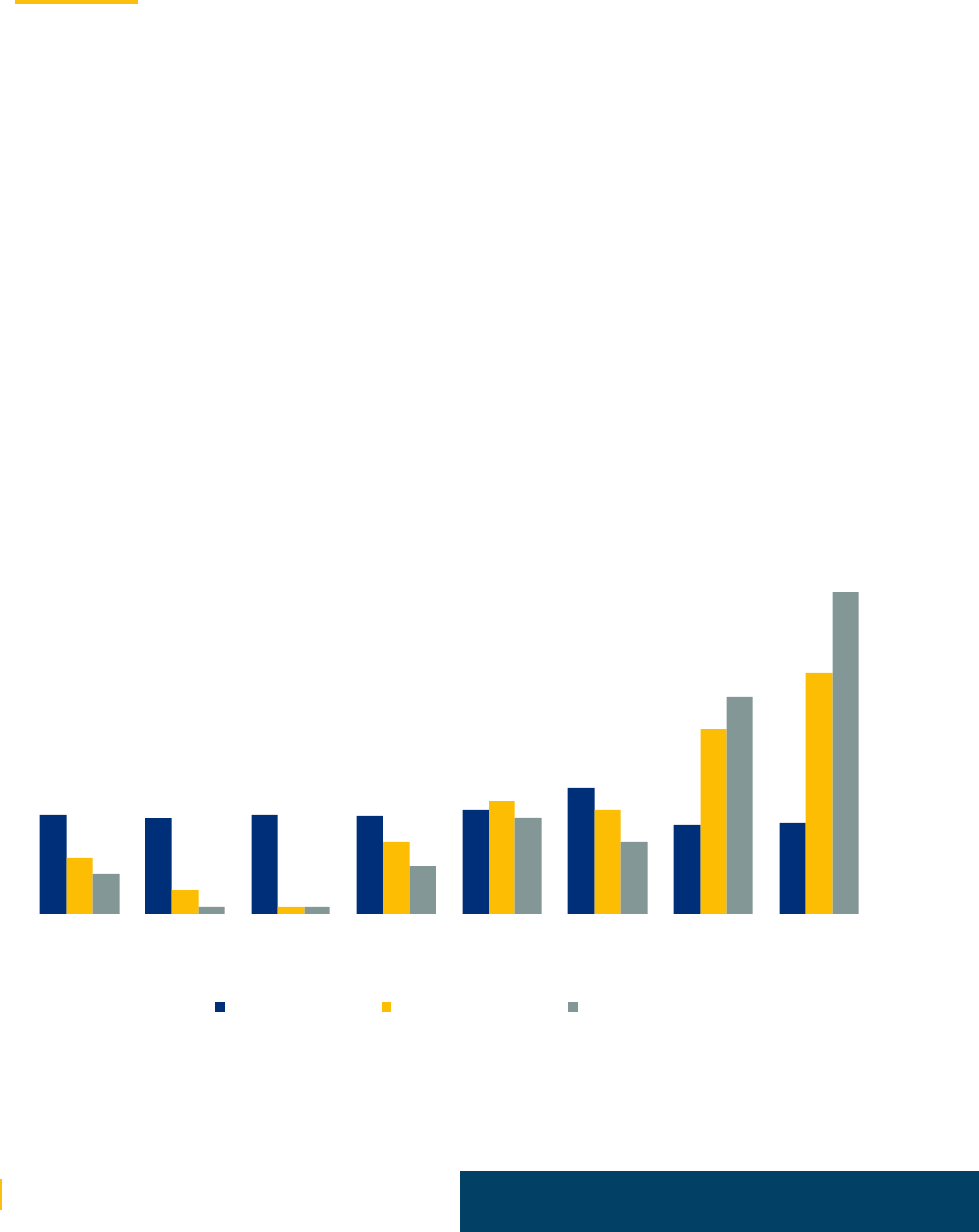
35
ESA FY2020-FY2021 ANNUAL REPORT
DHS Organization Summary
• Office of the Director (OD): The Office of the Director (OD) is responsible for managing, overseeing,
and supporting all agency activities to ensure that the mission of the DHS is fully executed. The Office
of the Director provides executive management, policy direction, strategic and financial planning, human
capital management, information technology, capital program, legislative and community relations,
performance management, risk management, and quality control.
• Economic Security Administration (ESA): The Economic Security Administration (ESA) determines and
maintains eligibility for cash, food, childcare, and medical benefits. Through a 2Gen approach, the ESA
also administers the employment and training programs for TANF and SNAP, which provide employment
and training-related activities designed to improve long-term employability and achieve sustaining income.
• Family Services Administration (FSA): The Family Services Administration (FSA) provides an array of
social services and supports for District residents to solve crises, strengthen families, and connect
residents to resources and programs to improve their well-being. FSA manages a system of care to
make homelessness rare, brief and non-recurring; administers a system of services and supports youth
at risk of court involvement, school disengagement, homelessness and repeat teen pregnancy; and
provides crisis-intervention services for families and refugees.
Figure 20. Households Receiving Benefits by Ward
12%
12%
12%
12%
13%
16%
11%
11%
7%
3%
1%
9%
14%
13%
23%
30%
5%
1% 1%
6%
12%
9%
27%
40%
Ward 1 Ward 2 Ward 3 Ward 4 Ward 5 Ward 6 Ward 7 Ward 8
DC (n=689,545) SNAP (n=141,551) TANF (n=39,615)
Source: Ward distribution of DC population is from US Census Bureau, 2020 Census Redistricting Data while ward distribution of SNAP
and TANF population is based on geocoding performed by DHS for individuals receiving SNAP or TANF benefits as of April 2021.
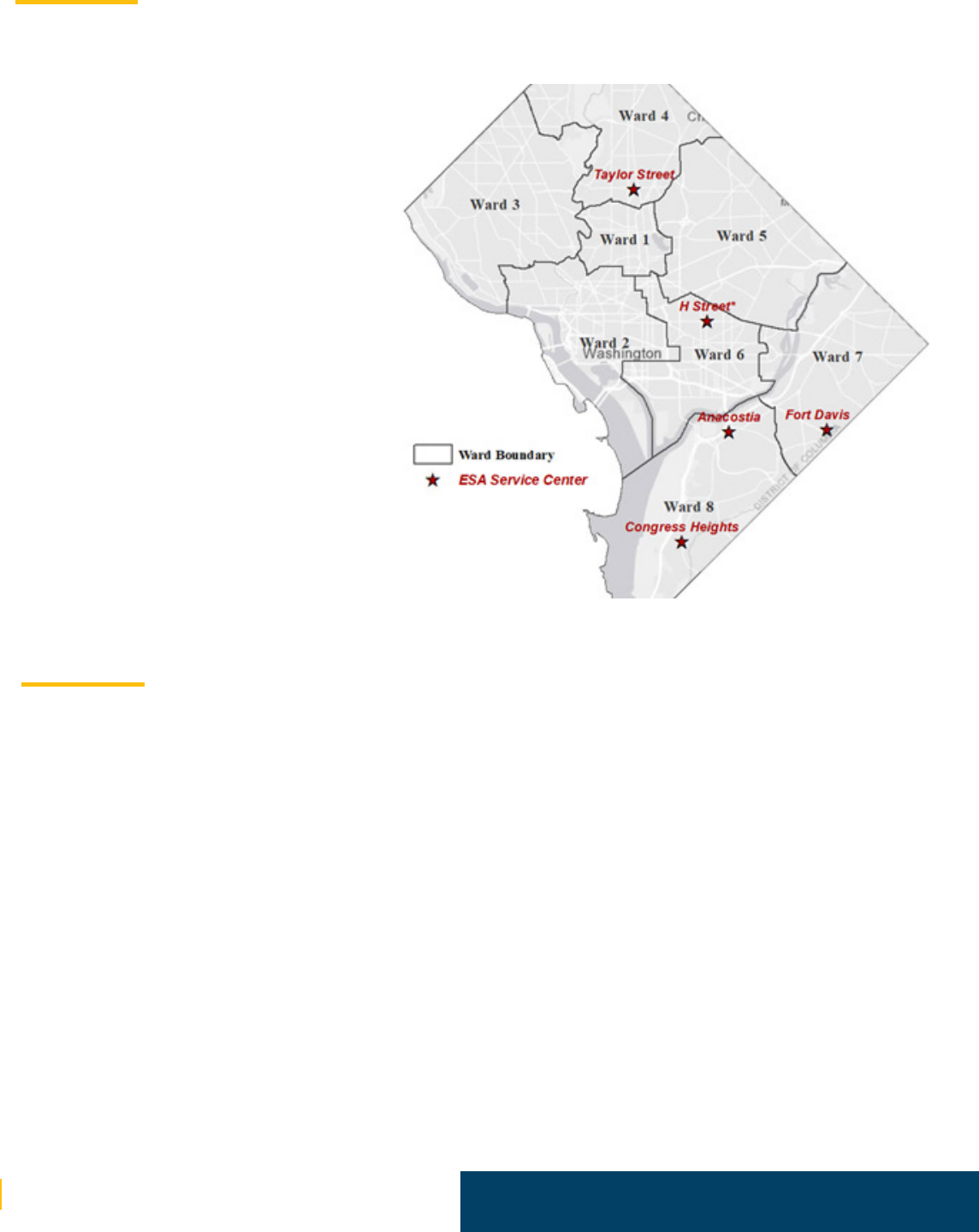
36
ESA FY2020-FY2021 ANNUAL REPORT
DHS Service Centers
H Street
645 H Street NE
Ward 6
Anacostia
2100 Martin Luther King Jr. Avenue SE
Ward 8
Congress Heights
4049 S Capitol Street SW
Ward 8
Fort Davis
3851 Alabama Avenue SE
Ward 7
Taylor Street
1207 Taylor Street NW
Ward 4
ESA Divisions
Division of Program Operations (DPO) is responsible for the direction and operation of the Division. The
Division of Program Operations is responsible for planning, structuring, and organizing an assistance delivery
system that provides a single point of entry for each customer regardless of the nature of his or her family
needs. The Division also reviews program operations to ensure compliance with regulatory guidelines; analyzes
the effectiveness of work methods and other functions of the administration; and consults with other division
regarding issues which cross Division boundaries.
Division of Customer Workforce Employment and Training (DCWE&T) develops opportunities to assist eligible
customers in job readiness, training and placement as required by the specific regulations associated with SNAP
and TANF; serves as contract manager for third party providers associated with those work requirements; and
establishes outreach programs and relationships with community resources. Office of the Deputy Administrator
staff performs training, data reporting, strategic analysis, program incubation and TANF Employment and
Education Program (TEP) services provider management. In addition, works with employers to improve
employment opportunities for eligible customers.
Figure 21. Location of DHS Service Centers

37
ESA FY2020-FY2021 ANNUAL REPORT
ESA Divisions
Office of Chief of Staff (COS) provides support to all divisions in ESA, including providing direct customer ser-
vices, conducting fair hearings, dispensing program guidance/advice, and serving as a liaison to the advocates. The
2Gen programs include, One Congregation One Family, the Fatherhood Initiative, the Grandparents Initiative, and
the Reentry Program. These programs provide services to specific populations already receiving a benefit through
the ESA. It has the Office of Administrative Review and Appeals (OARA), conducts informal administrative
review conferences for customers requesting hearings regarding all assistance programs administered by
the ESA and promotes collaboration with public and private sector partners. The COS also supports the entire
administration in short-term and long-term planning; system development and support, federal TANF, SNAP,
and Medicaid reporting; policy planning and research; and ad hoc special projects.
Division of Policy, Training & Quality Assurance (DPT&QA)develops plans, policy, and procedures to
administer economic security programs effectively in the District. The Division also evaluates and analyzes the
need for services promoting and supporting self-sufficiency for individuals and families; develops strategies to
promote cooperation with public and private providers; reviews federal and District laws and regulations to
ensure compliance; documents and translates changes in federal and local TANF, cash, SNAP, and Medicaid
laws; and provides oversight to monitor the performance of activities conducted in accordance with grants
awarded by the Administration. Other responsibilities include advising and providing technical assistance to the
Administrator and program managers; and recommending and participating in the development of legislation.
This Division also represents the ESA to the federal government when necessary; designs and implements the
ESA’s performance reporting systems; identifies the ESA’s training needs; and monitors compliance with federal
and District legislation.
Division of Innovation and Change Management (DICM) is responsible for ensuring that the program and
business interests of the administration are both addressed and prioritized across technology, data, and process
improvements. The team handles technology enhancements and manages projects throughout the agency as a
stable of project managers.
Division of Data, Analytics, Research and Evaluation (DARE) functions as the central unit handling the ESA data
analysis and research. Serving all programs, the division compiles and publishes data reports for both internal as
well as external consumption; performs quantitative and qualitative research on customers and program evalua-
tion; supports system data analysis to identify potential system related issues and errors; assists program opera-
tion and management in tracking, managing, understanding and utilizing data to improve the quality of services;
supports the design and implantation of both systems and policies across the administration; and interfaces with
internal and external stakeholders and partners in regards to data and reporting. DARE works with program staff,
policy staff and IT staff to support the ESA’s business needs.
Office of Administrative Support (OAS) provides administrative support services to the ESA. It directs the
preparation of the ESA’s annual budget, coordinates the recruitment, staffing, and classification of positions,
facilitates purchasing and procurement, manages ESA facilities and special projects, and coordinates the fiscal
planning, monitoring, utilization, and control activities of the administration.
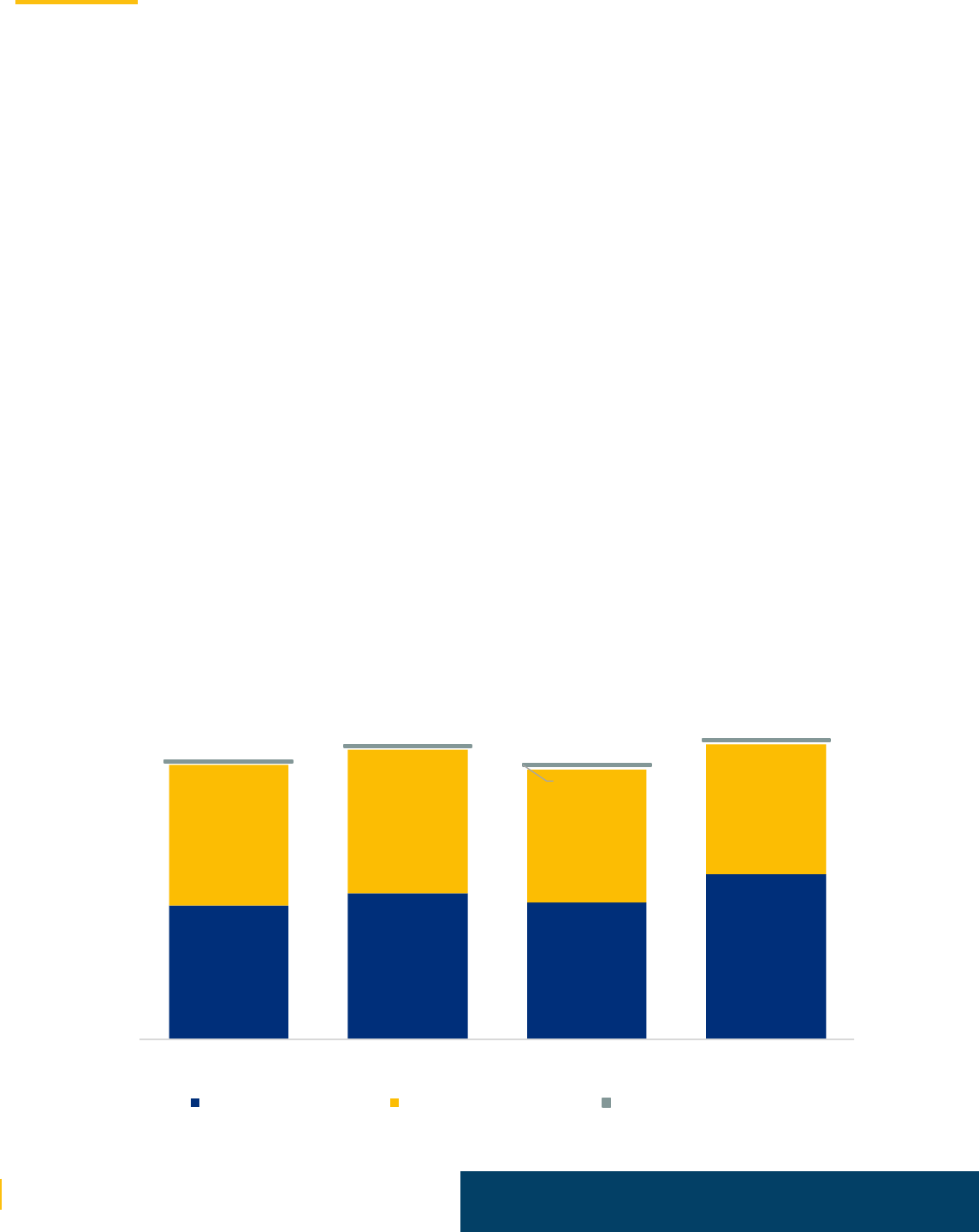
38
ESA FY2020-FY2021 ANNUAL REPORT
ESA Budget and Expenditure
The ESA budget includes federal funds, general funds
allocated to DHS, and intra-District funds transferred from
other District agencies to administer a range of public
benefit programs and support services provided by DHS.
The two most extensive benefit programs administered
by ESA are SNAP and TANF.
SNAP is a federal entitlement program regulated by
the Food and Nutrition Service (FNS) within the United
States Department of Agriculture (USDA). The federal
government directly pays the total cost of SNAP bene-
fits while splitting the cost of administering the program
with the states. Therefore, the ESA budget herein does
not include any SNAP benefits paid to District residents,
and only consists of the administrative funds allocated
to the District. The administrative funds cover eligibility
determination, program monitoring, and support services
that complement the food benefits. It should be noted
that the District appropriates general funds for the Local
Supplemental SNAP (LSS) program that is designed to
provide minimum food benefits to households whose
SNAP benefit is less than $30 per month.
TANF is a block grant awarded by the Administration of
Children and Families (ACF) within the Department of
Health and Human Services (DHHS).
The District has some flexibility to design and operate the
TANF program how it sees fit, including how to spend the
funds while adhering to the general terms and conditions
set forth by the federal regulation. In addition, the District
allocates additional local TANF funds to support families
who may not meet the federal requirements. The TANF
budget includes both federally awarded grants and local
funds that cover administrative costs and cash benefits
paid to customers.
The ESA also determines eligibility for all medica assis-
tance programs, regulated by the US Center for Med-
icaid and Medicare Services (CMS) and the District’s
Department of Health Care Finance (DHCF). Likewise,
ESA determines eligibility for Childcare Services, regu-
lated by the District’s Office of the State Superintendent
of Education (OSSE).
During FY21, the ESA spent $263.2 million to operate the
aforementioned benefit programs. This decrease of $18.4
million from the total expenditure in FY20 is attributed
to a reduction in the needs of certain types of in-person
supportive services during the continued public health
emergency. However, the spending in FY22 is expected to
increase due to increased caseloads and in-person activi-
ties per the budget ($287.3 million).
$129.3 M
$140.8 M
$132.1 M
$159.2 M
$135.2 M
$138.6 M
$128.2 M
$125.6 M
$266.9 M
$281.6 M
$263.2 M
$287.3 M
$2.5 M
$2.2 M
$2.9 M
$2.5 M
$0 M
$50 M
$100 M
$150 M
$200 M
$250 M
$300 M
FY19
(A ctual)
FY20
(A ctual)
FY21
(A ctual)
FY22
(Approved)
General Fund s for DHS Federal Funds Total Intra-District Funds
Figure 22. ESA Expenditure (FY19-FY21) and Budget (FY22) by Funding Source
Note: Amounts may not add to the total due to rounding.
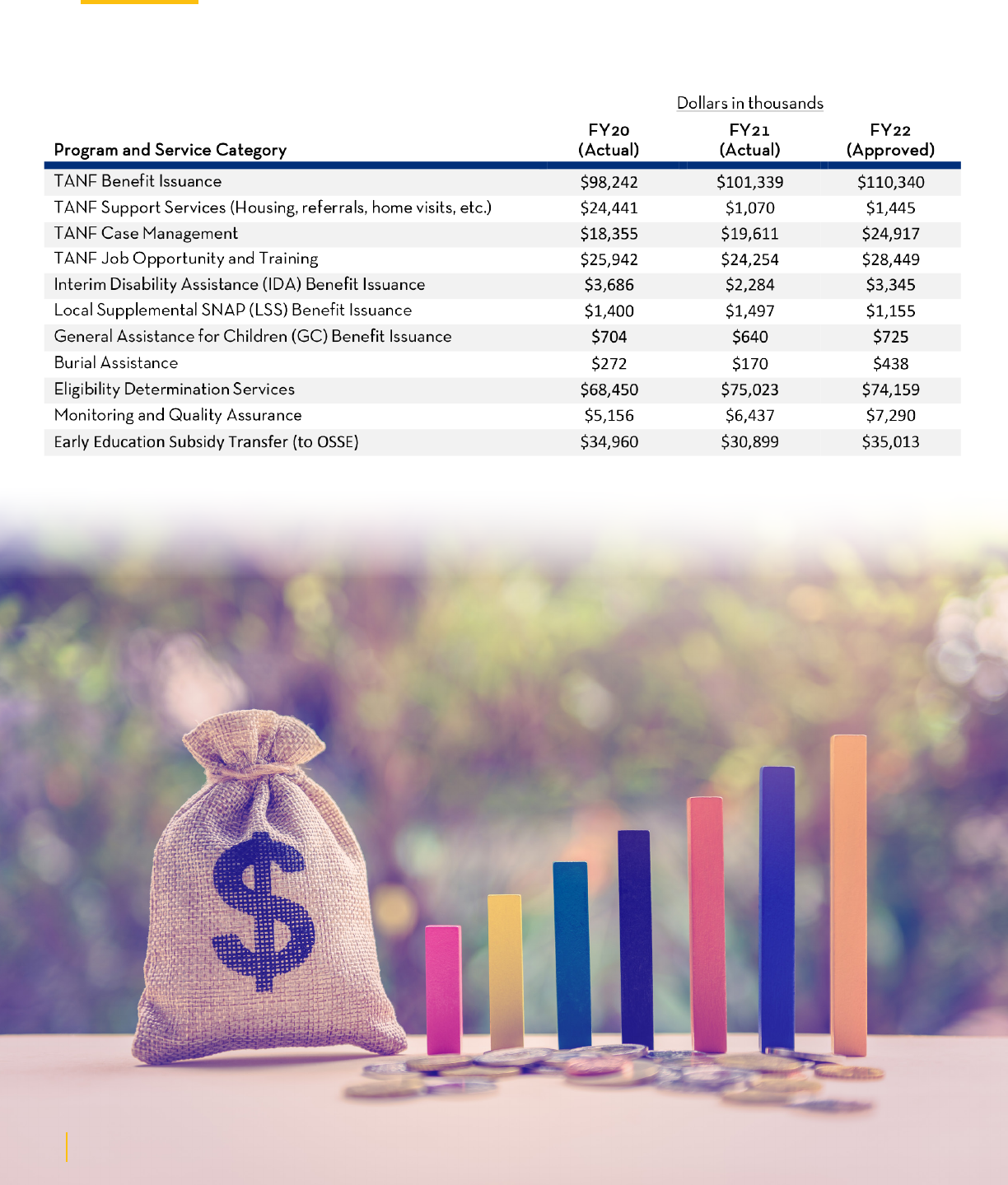
39
ESA FY2020-FY2021 ANNUAL REPORT
ESA Budget and Expenditure
Table 12. ESA Expenditure (FY20-FY21) and Budget (FY22) by Program and Service
39
ESA FY2020-FY2021 ANNUAL REPORT

40
ESA FY2020-FY2021 ANNUAL REPORT
DHS.DC.GOV
FY2020-FY2021 ANNUAL REPORT
